#being broadcast as the norm
Explore tagged Tumblr posts
Text

#comic#feminism#radical feminism#male dominated media#male perspective#isolating women from their own perspective#making women feel isolated for having a normal way of acting and thinking#radfem#male fantasies#male brainrot#male pornified versions of women#being broadcast as the norm#when its anything but#and women being forced to play it feel uncomfrotable and isolated from their own bodies and minds as well#male bs#written by a man disease
1K notes
·
View notes
Text
honestly i think i feel more comfortable w things like "miss" and other generally more childish ways to talk about. female people? i dunno how to de-age it. anyway what i mean is that gendered expectations & gendered everything vary quite a lot depending on people's ages, and especially (assuming no abuse is going on) there can be kind of a "free pass" for non-conformity when you're a kid, just like there can be a free pass for all sorts of polite social manners until you're too old to like, play in the mud.
if you call me miss, you're playing along, you're being jokingly overly polite to a little kid who is clearly not old enough to need an honorific before their name. it's like you're calling me a teen or an adult. if you call me ma'am you're seeing a woman. you're acknowledging what you see. the primary point has shifted from age to gender. and i don't know if i'm really comfortable being perceived as very much solidly a woman.
#i hated descriptors that were ''too feminine'' as a kid#but i think i can look back fondly because well i was a girl#i was a tomboy and a lesbian and a girl in many many ways#regardless of the fact that i was a trans boy at least sometimes#or some kind of nb#but i don't know. i certainly want to go past that#and yeah adults are much more defined by gender-job-everything else#than kids. who are maybe more like age-personality-gender#(which i understand is not the experience of everyone but yeh. true for my life.)#homosociality and gendered sociality are factors then too but it can often be easier to break free from it#because as adults you are aware of it and able to analyze it and keep it in mind. whereas kids are often unaware.#or maybe i was supremely unobservant as a child idk#so that's the thing. i certainly don't reject everything of girlhood and womanhood#but i absolutely do reject this ideal reasonable adult womanhood where i'm supposed to cave to doing things the normative way#not only because i just don't like that way but also because it very much feels like disguising myself into something i'm not#i don't know#i don't think i'm fully a boy or a man or anything. or maybe occasionally at most. but it's comfortable not having expectations#of the kind of man i have to be#if only because me being a man makes me a trans man and people don't put expectations of manliness on someone they think is a girl#anyway fuck gender i'll never be free#broadcasting my misery#vent
2 notes
·
View notes
Text
There was lots of concern about AI and deepfakes spreading misinformation this election cycle, so let's check in on that!
A lot of right-wing accounts are trying to prove that Kamala Harris' crowds are fake - that all the photos of them are generated with AI. We'll get to that, but let's look at the most...amusing example first.
There's lots of people pointing at an image of a crowd that's obviously been generated with AI, due to extra arms and gibberish writing.
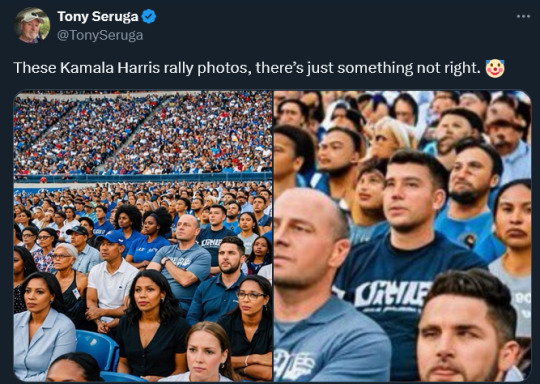

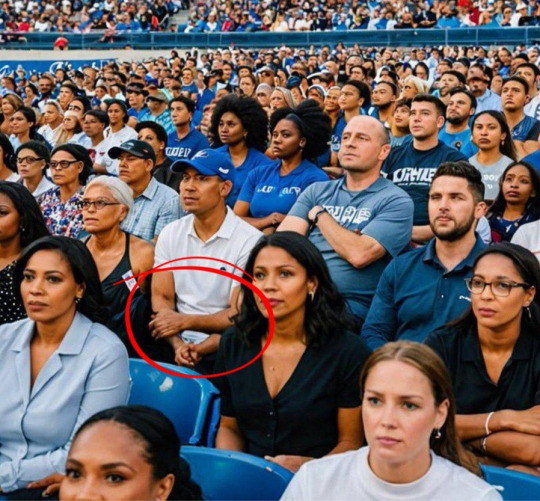
So obviously someone generated this image with AI. Who was it and why? Well, we can actually find the origin pretty easily. It was...

A right-wing satire account. Who put "unexcited Kamala Harris crowd" into a AI image generator to make a "wow, crowds are electric!" joke.
An image their own side generated as satire is now being spread by the right as something Harris/Walz created as proof they're doing the thing they're doing. Incredible. Just a masterclass
Now let's look at the dark stuff.
By and large, AI isn't being used for hoaxes. AI is being used as a excuse: people aren't being tricked by AI images, they're being tricked by accusations real images are AI.
So this hoax went around recently...
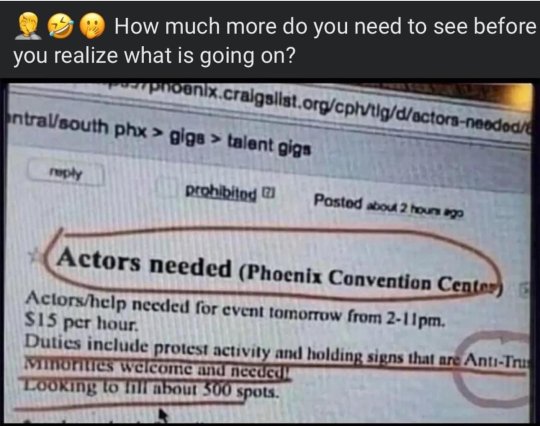
This image is old. It spread in 2017, it spread in 2020, and now it's spread in 2024. The Harris/Walz rally wasn't even in the Phoenix Convention Center, or in Phoenix. But it's now a core part of the "no one's attending their rallies!" campaign going on now
This may seem strange if you experience the news by non-conservative media, where you can't escape stories of Kamala Harris filling up massive stadiums & of Trump rallies full of empty seats. All evidence in reality points to Kamala Harris being extremely popular and to Trump's campaign faltering.
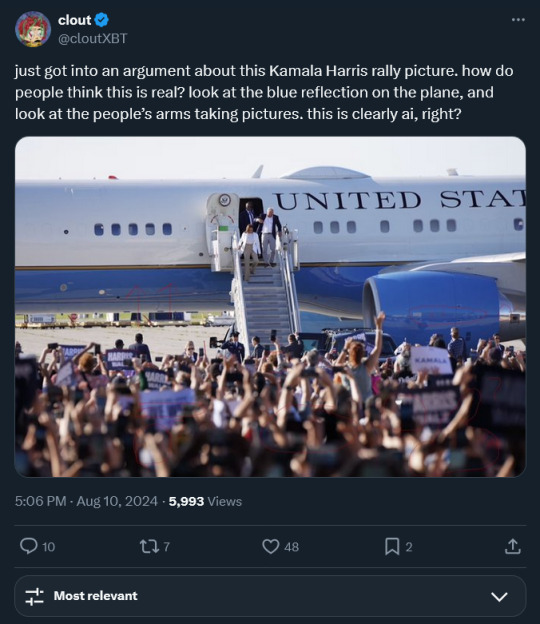
But in MAGA land, Kamala Harris' crowds were generated with AI.
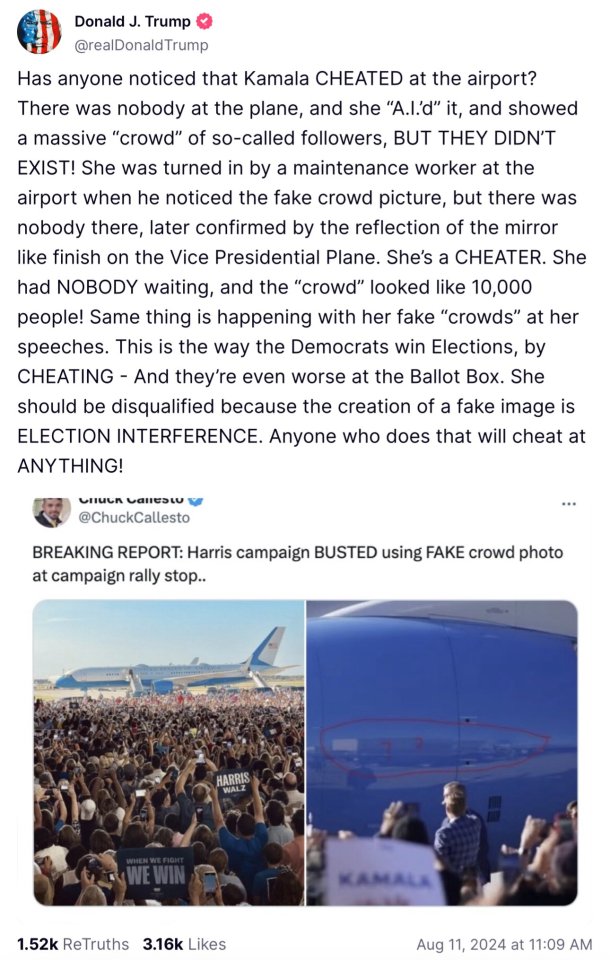

Their claims: the crowd isn't in the reflection, and uh, the arms look weird. But also that there "aren't any other images".
But? There are? There was a livestream of that very plane landing (starting at 25)!
They're subjecting what they think is The Only Image of this rally in long Youtube videos and on Twitter and TikTok, and just...don't realize there's full, uncut, commentary-free video of it that was broadcast live. So why don't they realize that?
Well, I did a search for this rally on Fox News' website and guess what? They reported it exactly twice: once a interview with her while leaving that slammed her for "not taking press questions" enough, and a few clips of the Palestinian protestors at it, but not many, bc if you don't follow the far right they're trying to frame Kamala Harris as, like, a radical pro-Palestinian (or, as they say, "pro-Hamas") activist who wants to destroy Israel which, uhhhhhhhh
But another thread I found debunking this, by a former Trump-voting evangelical conservative turned critic of the same, gets at the heart of it

People who said AI and deepfakes would be used to mislead the right were missing how misinformation actually works. Fox News et al don't suppress information by confusing the audience with misinformation; they suppress information by never letting them see it in the first place. They know that they have a captive audience who doesn't watch non-right-wing news (unlike the left, who are constantly aware of what's going on over at Fox).
They can just never mention or show Kamala Harris' rallies, or do so only in close-up, and they can frame Trump to only show shots where a crowd has gathered & make it seem like that's the norm, and their audience just has no chance to find out the truth. They're so propagandized that they just accept that there are no other images of that Kamala Harris rally, because, well, they were told there weren't, and would the news personalities they trust really lie to them?
And if any stray bits of reality float into the bubble, well, it was just AI. You know, how they have AI these days? AI's most important role in all this isn't as a vector for misinformation, it's as a rhetorical device for claiming real images and video are misinformation. You don't have to make images full of people with weird hands if you can get people circling real people's hands in red and pointing at it to prove reality was made in a computer.
These people don't know how popular Kamala Harris is. They don't know she's polling eight points higher than Trump. They don't know Harris is leading in right-wing biased polls. They're being told she's hiring actors at rallies, that her crowd photos are generated by AI, that Trump rallies are popular and hers are desolate.
This only likely to increase as we near the election because, well, Trump '24 is a shitshow. His campaign started out less popular than '16 or even '20, he picked maybe the worst VP pick in history, and he hasn't made a single effective attack on Harris/Walz. They were banking on facing Biden, and then on a chaotic open convention, but instead everyone closed ranks around Harris, and she instantly became the most popular Democratic candidate since 2008. We are cruising towards Trump/Vance not only losing, but losing in the closest thing to a landslide that's possible in our current system.
They're already laying the groundwork for, in the likely case of defeat, playing the "she stole the election!" card. Last time it was ad-hoc, because Trump thought he'd win. This time, they're already making "all her rallies are fake, all of her supporters are AI, they've already rigged it against Trump" a key strategy, and, I have to assume, their primary strategy as it gets closer to election day and the polls get worse. They've always lived in a bubble, but now it's a bubble designed explicitly to cause another January 6th. By claiming real photos have weird hands, and must totally be AI
1K notes
·
View notes
Text
A devastating and confusing thing about the Fallout setting, when you explore the pre-war aspects, is what the creators think about pre-war America. In the first games we only get hints of the pre-war world, but they seem to be some sort of wild fascist nation invading Canada. In Fallout 1, the first thing we're introduced to of the pre-war society is seeing a soldier shoot civilians and laughing.
Now, for the first 2 games and New Vegas we don't really know much. What we know is that there's a fascist military group known as the enclave who were a sort of US deep state even before the war, and that the government teamed up with corporate interests to preform vaguely MKULTRA-ish experiments with the Vaults. Basically, the government was an extreme version of the 50s American jingoism and McCarthyism.
This is well and dandy, I guess issues come up more when we get to the later games, especially 4, where it seems like none of this extreme plotting and societal civil unrest which would exist is seen. The society as presented in 4 also seems quite progressive, gay people are featured in the opening, and none of the baggage of say, civil rights not existing are included. Now on a baseline, I don't want settings to be more conservative, homophobic and sexist etc., but it becomes a very confusing setting when it's displayed both as this jingoist extreme thing with fascist tendencies aswell as a progressive place where everyone is seemingly equal. If you're focusing on the 50s as your setting, and American nationalism in the 50s, then you can't have McCarthyism spoofs and anti-communism as a societal paranoia norm while also general equality is the norm without misunderstanding why McCarthyism and nationalist jingoism is bad. A massive harm done in anti-communist paranoia is how it degrades and vilifies any progressive movements (women's rights, civil rights, homosexuality) as being morally un-American and therefore connected to communism. To ignore this just makes any critique of MacCarthyism and jingoism weird!
Basically, pre-war America in Fallout 4 becomes this both sides thing where America is both pure and equal and white fences in every instance that we see as the player (the intro), while also supposedly being this dystopic MacCarthyist hellscape that's broadcasting gladly about their war crimes in Canada, and wants to root out communism. I guess the only fix for this issue without getting into the fine print like they had to do is just not to focus too much on the pre-war world.
#fallout#fallout 1#fallout 2#fallout 3#fallout 4#fallout new vegas#fo1#fo2#fonv#fo4#I'm almost half-way through the show#it suffers from this too but whatever I'm just going to count it as it's own thing#it gets a pass or whatever. telling a video game story and telling a tv-series is completely different#they can do what they think is useful.#We see a bit of what the I'm talking about in New Vegas with mr house being able to be that rich etc#but new vegas cares more about the fallout of Fallout 2 + new ideas than some pre-war America. The most we get is like Poseidon energy and#Raul. but Raul doesn't really care that much about the details of the past world#his life seems pretty normal. it's not that important.#dead money and owb did this like... Okay. wasn't too bad it was fine. I don't like those DLCs too much. Dean Domino is whatever
682 notes
·
View notes
Text
Project SEKAI 4th anniversary: Brand New Your World - recap post
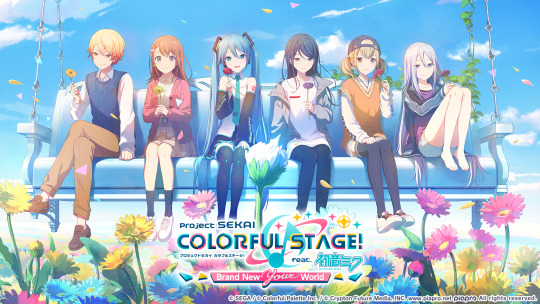
Much like last year, I thought it would be useful to make one long post recapping all of the information about the 4th anniversary updates. Even if there won't be as many major updates and changes as last year, we still will be receiving news about other related projects like the movie during the anniversary thanksgiving festival, so I'll be recapping that too.
Note that all of this applies to the JP server only.
Official site link

Before we start, the next Broadcast Station episode will be held on the 27th, featuring Isobe-san, Jiena, Imai-san, and Daichan. It will be broadcast live from the Thanksgiving Festival. Related event speculation will be done in a separate post, and the stream itself can be found here.
Section 1 - Game Updates
Most game updates will be announced during the aforementioned Broadcast Station stream, but some things have already been announced, such as:
Virtual lives (after lives/holiday lives) will now be held every hour, cutting the long wait times between some showings.
You will now be able to collect character rank XP for an entire unit in one go, rather than going to each member's page individually.
Calendars for songs and events will be released in advance, so we finally will actually know in advance what days songs are being added and what days events will run (though by the sounds of things, event lineups will be kept a secret outside of the unit).
Broadcast Station News
A new game mode has been added, called MYSEKAI. It's an Animal Crossing-esque side game that will be available through the main app. More details on this will be in section 6.
A story completion progress tracker will be added. You can earn crystals and gacha tickets based on your progress
You can now earn gacha tickets through Clearing and Full Comboing songs on different difficulty levels. These can only be claimed on the first time you clear/FC a song of each difficulty from 15 to 37. Autoplay doesn't count and you can earn up to 140 tickets.
All Kizuna ranks will be added! All of them! However, the new ones will not have specific titles or unlockables for levelling up the rank. Instead you will be given a title that says "X & Y Fan". The unlockables will be implemented when relevant.
You can now autoplay during Challenge Show. You will also be able to get CH show rewards up to a score of 2.5 million, as well as increase CH rank up to level 150
Project SEKAI is opening a store on their official website. You will be able to buy gems and get some freebies by using it. You will have to use your apple/google account to sign in. By the sounds of things this will replace the in-game crystal shop
Max character rank has been increased to 160, and as always new titles for max player rank and daily login will be added
As per the norm, character rank missions will be increased
Live bonus has been reworked. You will now be able to recover up to 15 bonus energy naturally (the limit is currently 10), and you will be able to overfill the meter to 999 instead of 99. Bonus energy's effect on event pts will also be reworked, refer to the chart below for the new bonuses

It will now be easier to obtain another vocal tickets. Their cost has been reduced in the event exchange and wish piece exchange, and two tickets will be given out from character rank and birthday lives. However, to balance this, the cost of a solo alt vocal has been changed to two tickets. The amount of another vocal tickets you own will be adjusted accordingly in the update.
Fes cards will now count as event bonus towards the event they were released alongside. E.g, the Rui and Rin Bloom Fes cards will count as event bonus for the upcoming Nene event.
The rewards earned from completing the tutorial will be increased. Existing users will be compensated accordingly.
You will now be able to exchange limited gacha tickets for wish pieces
All stories will now be fully voiced, even for faceless NPCs. Currently unconfirmed if this will apply retroactively
Starting from October, the number of random rerun limited gachas will decrease to one. This is because they ran out of gachas to rerun.
Birthday gacha reruns have been reworked. Rather than rerunning all past birthday cards separately, they will now be lumped into one gacha.
Kizuna rank for Honami/Mafuyu, Saki/Mizuki, and Haruka/Len implemented
Section 2 - Campaigns
Here's a list of all the campaigns and gachas that will be running over the next few weeks.
Fortune Flower Parade
This campaign will be held from September 30th for one month
You will be able to collect Fortune Flowers and Petals from event exchange, live missions, and stamp missions.
You will be able to exchange those items for some other special items, such as costumes, skill up scores that will instantly max out your skill, Character Rank XP vials, and some special wish jewels (i'm not exactly sure of their purpose but they have a unique design)
There are six different colours of petals and each can be obtained through different methods and be exchanged for different items. Refer to the chart below

Present 4 You
To celebrate the fourth anniversary, four presents will be given out to players
Present 1: Five 4* guaranteed gacha tickets will be given out to all players. These will also replace the 3* tickets for any new players.
Present 2: All another vocals will be released on youtube for two weeks. You will also receive two another vocal tickets for every character.
Present 3: There will be an in-game survey asking players to pick their three most wanted prizes from a list for the next couple days. The three most picked prizes will be awarded at a later date.
Present 4: There will be a prize giveaway on twitter. For following their twitter and retweeting the campaign post, there's a chance to win some prizes (they're really random like a gopro and a coffee machine lol).
Other campaigns and gachas
Login campaign: Earn up to 5000 gems and 7 10-pull tickets from logging in for a week after the anniversary.
Operation Welcome to SEKAI will run again
Special Prize gacha: a gacha where you can earn prizes the more you pull in it. This will run between the 28th and 30th of September. It will also have doubled 4* rates.
Stamp missions and paid costume gachas as per the usual
Happiness Package gacha
Limited edition select list and memorial select list (same as last year)
Section 3 - Songs
Anniversary Song
The fourth anniversary song has been announced! The title is Neppu and it was produced by kemu! Below is kemu’s comment on the song (via @/pjsekai_eng on Twitter).

Song Campaign
The song campaign hint sheet has been revealed, and actually has hints again for the first time in a while. The answers will be revealed during broadcast station on the 27th.

Note: blank tiles include special characters
Answers
Mozaik Role -Reloaded- by DECO*27 (L/n cover + 3DMV)
Mesmerizer by 32ki
Kisaragi Attention by JIN (MMJ cover)
Main Character by *Luna
Call Boy by syudou (BAD DOGS cover)
Kimi to Boku no Resonance by nanameueP
Tensei Ringo by PinocchioP (WxS cover)
Blackjack by YuchaP
Shadow Shadow by Azari (N25 cover + 3DMV)
Outside of the campaign, we also have Cat Food by doriko covered by MMJ + Miku.

This year's high-difficulty commission has also been announced. The song is called Seimeisei Syndrome and was produced by Camellia. It will have a master difficulty of 33 and an append difficulty of 36. A preview can be viewed in the livestream archive (for some reason it was not uploaded to Twitter).
Section 3 - Lives
4th live


Project SEKAI's 4th live was announced last month, titled Unison!! The live will be held in two locations: Osaka on December 13th-15th, and Tokyo on January 24th-26th!
A PV can be found here!
The official account for all information about the live is, as always, @/pjsekai_live on Twitter.







Here are some close-ups of the group artwork above, as well as some chibi artworks. The costumes used as the ones that will be available from the Fortune Flower exchange.
youtube
A video teaching player the glowstick movements and chants for I'm Mine has also been posted to Youtube!
Connect live

A connect live to celebrate the fourth anniversary has been announced. It is titled Brilliant Stage and will be held on the 6th of October! There will also be a "meet and greet" session after the two performances of the live, similar to Resonance Beats. A short login story to commemorate the live will be available on October 5th & 6th.
A medley of previously unperformed songs will be performed during this connect live. The songs were given as Aioi, Hug, Hitsuji ga Ippiki, CYBERPUNK DEAD BOY, and I nandesu.
Section 4 - Event and gacha


The next event will be Carry These Feelings! Dream Stage, a Nene-focused event. Shiho, Airi, and Toya will be the other rateups! The 3* is Ena based on the event logo. Rui and Rin will be featured as the Bloom Fes cards.
The bfes gacha will be Dream Pick, utilising the same system as last year (you get two extra slots to fill). You will also be able to get Fortune Flowers as a reward for pulling on this gacha.

As mentioned earlier, there will also be paid costume gachas. You will be able to earn Fortune Flowers from pulling in these gachas. Here's a preview of the costumes.
Section 5 - Project SEKAI: The Movie
youtube
A Project SEKAI movie animated by P.A.WORKS was announced back in July. More information on that can be found here. A new trailer was shown during Broadcast Station, which can be found linked above. Some new character visuals will be posted below, but aside from that, please refer to the linked post which will go into the new information in further detail.






Section 6 - MY SEKAI
youtube
MY SEKAI is a new gameplay feature that will be added during the 4th anniversary. It's an Animal Crossing-esque farming/life sim game that you can play using your Virtual Live avatar. You can build you own SEKAI and house and decorate it however you like! You will also be able to talk to chibi versions of the main characters and interact with them, as well as visit your friends' SEKAIs!
Your MY SEKAI will also have a new feature called the transformation machine! This is where you can exchange some of your excess resources into things that are more useful to you (that's right they finally made the materials exchange).
I do not know how much storage or power this will take to run. I am very sorry for your devices.
Section 7 - Misc News

A livestream leading up to the 4th anniversary has been scheduled for 29th September at 11:30pm JST (2:30pm UTC). The stream will feature Chiruriin, Honchan, Akina, Daichan, and Ruirui.

A digest video of the previous Colorful Lives will be shown on Youtube on the 5th of October at 6pm JST (9am UTC). This stream will not be archived, so make sure to catch it!
#project sekai#will be updated as new information is released#(also!!! updates will probably be slow on the stream day because i have uni induction stuff literally right after the stream lol)#Youtube
211 notes
·
View notes
Text
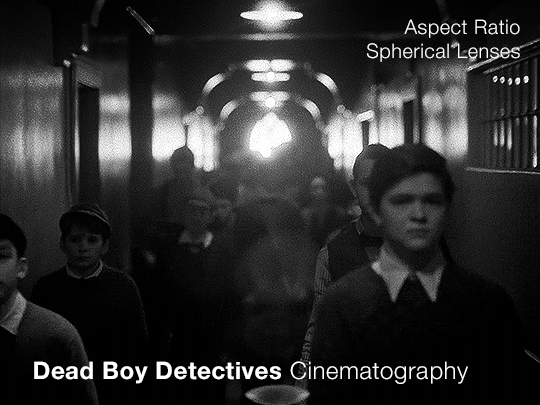
Part 2 — this time with a focus on the flashbacks
(Check out the first post for some background info that will be useful)
When we’re looking at the cinematography of any piece, once we’ve established what the norm is (which is the use of anamorphic lenses, as per the last post) we can then look to see where it diverges. As far as I can tell, the only part of Dead Boy Detectives that doesn’t use an anamorphic lens is Edwin’s flashback scene.
Now this is particularly interesting since not only is it filmed with a spherical lens, but it also is the only scene with a different aspect ratio, and the only scene in black and white. Everything about this scene is glaringly different. The easy and obvious reason is that it sets this scene apart as something important to pay attention to, as well as emphasizing the difference in the time period. But I want to highlight how exactly it does this since it is quite clever.
It also raises the question: Why not film Charles’ flashback scenes differently?
Like last time, let’s start with a review of history and technical information.
What is an aspect ratio?
This is just the ratio of the width to height of the frame. 1:1 is a square, whereas 2:1 is a rectangle twice as wide as it is high. In film, aspect ratios are usually listed as a ratio of x:1, so you get common formats like 1.85:1 and 2.39:1 (the second being a super-widescreen format, i.e. a long rectangle). Other common ratios are listed with different numbers, like 4:3 and 16:9. Any time I write an aspect ratio with other numbers, I’ll also list it at least once with the x:1 format so you can compare things easily.
What are some common aspect ratios and what have the standards been across the past 100+ years of film and television history?
Brief history of aspect ratios in Film
The original silent films were mostly filmed in 4:3 (1.33:1). This aspect ratio persisted until the late 20s/early 30s when the Academy Ratio, 1.375:1, was introduced and somewhat standardized (at least in the USA) until the 50s. Then, widescreen became pretty popular and was used to draw audiences to the theaters. At this point, we get tons of variation in aspect ratios in films. But, for American theaters, common projections are 1.85:1 (which became super common) and 2.40:1 or 2.39:1, whereas in some European theaters, 1.66:1 is a more common ratio.
Some other common ratios deal particularly with 70mm film:
Standard 70mm film is usually 2.2:1. However, using anamorphic lenses will create a higher aspect ratio, and unless using a specific format common in the 50s and 60s (Todd-AO), this wasn’t often the aspect ratio that viewers would see. (The Sound of Music was shot with Todd-AO in 2.2:1, but until recently, most people only saw the general release in 35mm, which had a different aspect ratio)
IMAX, which is 1.43:1 (if IMAX is shot on film and not digital, it uses 70mm film)
Brief history of aspect ratios in Television
Pretty much all televisions until around the 1990s-2000s used 4:3, and broadcasters would show content in that aspect ratio. If a movie was broadcast over TV, sometimes there would be letterboxing (black bars), but pan-and-scan was common, where they would crop the movie to the 4:3 ratio, and pan around to wherever the action was happening. Starting in the 90s, widescreen televisions started to gain traction, and the 16:9 (1.77:1) format prevailed, and TV broadcasting had some more wiggle room for aspect ratio.
**Side note: Computers are often at this ratio, so if you watch older TV shows on your laptop, you’ll probably see pillarboxing (black columns on the sides), whereas newer movies are often shot with higher aspect ratios so they have letterboxing (black bars on the top and bottom)**
A note on widescreen
Movies are usually considered widescreen if they’re any higher than 4:3 (or 1.33:1). However, because of the aspect ratio of modern TVs and computers, and the even higher aspect ratios of most smartphones in landscape mode, a lot of people (especially younger generations) won’t consider things “widescreen” until they’ve got a much higher aspect ratio.
Streaming and Aspect Ratios
A weird effect of streaming services, and in particular Netflix, was the rise of a new standard in aspect ratios, 2:1. It’s used in shows like Stranger Things. It’s widescreen enough that it feels cinematic but it displays well on lots of devices. There’s minimal letterboxing (or none) on your phone, and more letterboxing on your computer and TV, but not enough to seem like you’re watching a movie instead of a show.
Netflix (and Amazon) really like this aspect ratio. In 2017, one of the production requirement documents from Netflix stated that any aspect ratio greater than 2:1 had to be subject to further approval (though now they state “Aspect ratio choices should be discussed with Netflix for approval”). It’s become increasingly common, and these companies have a pretty set standard for 1.9:1 and 2:1. If we see those ratios on a streaming show it isn’t always a creative choice, similar to the way older TV shows were required to be in 4:3.
A brief reminder about lens types with some extra bits about the timeline.
That 2.39:1 aspect ratio that movies use? That’s the standard for anamorphic lenses (discussed in Part 1). Anamorphic technology was developed around 1915 (for military reasons), but wasn’t used for films until 1927, and didn’t become commonly used until the 50s.
So, with that, let’s look at Dead Boy Detectives.
Aspect Ratio
The whole show is shot with anamorphic lenses, but instead of a 2.39:1 ratio, they use a 2.2:1 ratio. This is a really interesting choice since it is an uncommon ratio. It’s more widescreen than Netflix shows (they started shooting before being acquired by Netflix though so we can ignore any impact Netflix may have had on this decision) but not quite the widescreen that anamorphic lenses typically use.
Movies and shows can use almost any aspect ratio today, but it is still common to stick to the standards. When they choose something else, it’s not because of technical limitations, but because of a creative choice.
The one caveat I have is that Doom Patrol used 2.2:1, so it’s possible that HBO and DC originally just chose this for continuity between the two, before the show was shifted over to Netflix and the Sandman universe. But for this post, I’m going to assume that they were sort of starting from scratch when choosing the look.
If we consider what a 2.2:1 ratio has been used for, and what viewers have been “trained” to associate it with, we end up with Todd-AO 70mm prints and a few others from the 50s and 60s. It’s the kind of aspect ratio you don’t see often unless you’re lucky enough to live near a theater with a 70mm film projector. There are a few notable movies shot in this aspect ratio: Lawrence of Arabia and 2001: A Space Odyssey. Some more recent movies that used 2.2:1 include Dunkirk, Tomorrowland, Nope, and the non-IMAX parts of Oppenheimer. It’s also occasionally used in recent TV, but not a ton, and not with many popular shows.
This is an aspect ratio used by large-format, high-budget movies. As mentioned in the previous post, anamorphic lenses are associated with a romanticized notion of “cinema” and this aspect ratio only serves to further that, associating Dead Boy Detectives with the limited pool of content made in this aspect ratio. It may be a TV show, but it’s being shot like a movie.
Another really interesting point that follows up on the previous post is the idea of using cinematography to enhance the sense of the supernatural and separate the characters from the normalcy of the real world. The aspect ratio is a bit unnatural too, which serves to complement and augment this.
Let’s briefly look at what the show would look like in different aspect ratios. As a baseline, this is the 2.2:1 aspect ratio that the show is in:
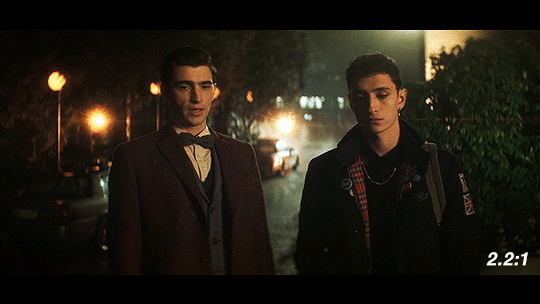
If they had gone for a 2.39:1, a very typical aspect ratio for the kind of lenses they’re using, it would look like this:
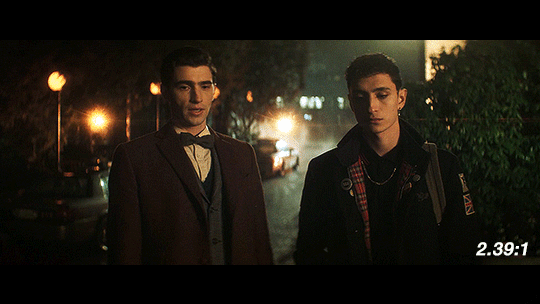
When we see things shot with anamorphic lenses, we’re used to seeing it in a frame like this one. Especially in shots like this with the dramatic lens flares, this is going to look and feel familiar to people who watch a lot of movies. It has more of that Star Trek (2009) look, and feels kind of glossy and polished.
Next up, we have 2:1, the aspect ratio popularized by Netflix. It’s a reasonable possibility that if this show had been produced by Netflix from the very beginning, this is what it would look like.

Over the past few years, this has become the “streaming platform” aspect ratio. With the extra vertical height, it’s got some extra space to breathe. We would get less of the background and more of the characters, especially since Dead Boy Detectives favors centered shots of single characters over group shots like this one.
Finally, I’ve got the scene in 1.85:1, a ubiquitous film aspect ratio, yet one that is not used often on TV.
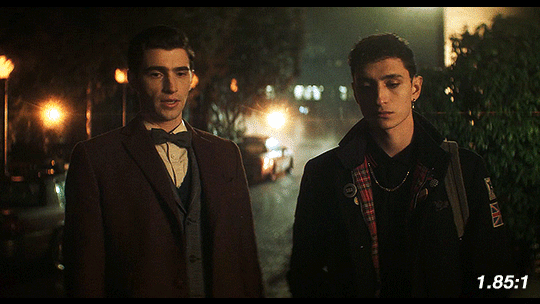
This is considered to be standard widescreen and it’s a great aspect ratio. Given how many creative decisions in this show were made to emphasize the supernatural, this could have been another good option as an aspect ratio, since we’re not used to seeing TV shows like this. However, they’re using anamorphic lenses so this would have required a lot of cropping. Because of how the anamorphic lenses work, this would also necessitate a lot of additional attention during the shoot. If they had gone with 1.85:1, we likely would have gotten a show shot on sphericals instead.
So what about Edwin’s flashback?
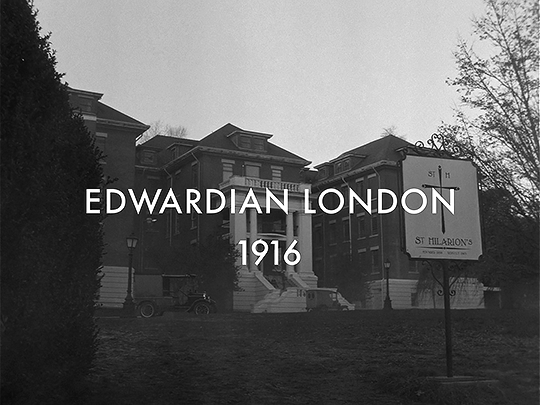
This section is shot in 4:3 (1.33:1). It’s the only part shot in a different aspect ratio. Sure, changing the aspect ratio forces us to acknowledge the difference in time period, but why exactly does it work so well?
Remember the history part? 4:3 was used for most of the early silent films. If we are to consider the “historical accuracy” of shooting the different time periods in this show, anamorphic lenses and 2.2:1 make sense for the present-day parts and Charles’ flashback.
But in 1916, widescreen cinema wasn’t a thing. If Edwin had ever been to see a movie while alive, it would have been in 4:3. The first time he would have ever gotten to see something in widescreen (if we assume he watches any movies at all) would be after he escaped Hell.
Using this aspect ratio is not just a vague decision that a lower aspect ratio and black & white looks older. It is, like many other aspects of the show, historically informed. They could have used the academy ratio here, but they didn’t. They used 4:3.
Not only does the aspect ratio switch for this scene, but also the height of the image changes.
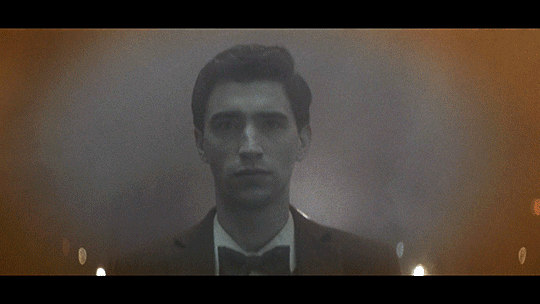
This transition also sort of mimics the breathing effect of anamorphic lenses:
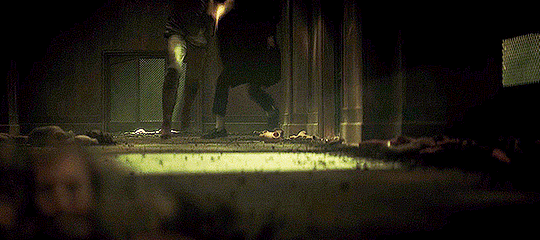
Something you may not know about how Netflix usually works is that regardless of the aspect ratio of the picture, the video file you see is part of a larger container, which is usually 16:9 (1.77:1). The black bars on top and bottom are part of the file, as shown in this screenshot of how it looks when you load up some screencaps in photoshop.
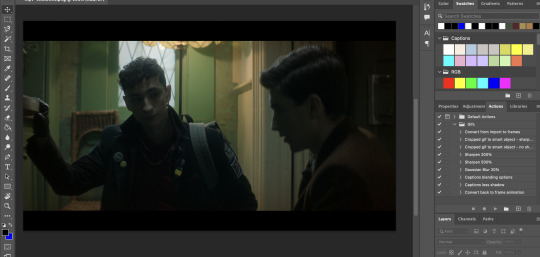
If you make gifs, edits, or are otherwise just used to having video files you are probably familiar with this. The Dead Boy Detectives files have letterboxing that is cropped out whenever people make fan content with it, whereas if you have a file for an independent movie, it usually does not have those black bars. Those black bars being part of the file make this transition possible.
We don’t usually realize that the container extends beyond the picture. For all we know, that’s the edge of the frame. But then it changes and forces us to reconsider what we previously thought to be true. Breaking out of what we think to be the image height is jarring, especially considering that this is the only time it happens (other than the brief flashbacks to the same footage later in the show).
Here’s a mockup of what it would look like if they kept the same image height, and just moved from 2.2:1 to 4:3 without expanding vertically. I find that it doesn’t have quite the same effect.
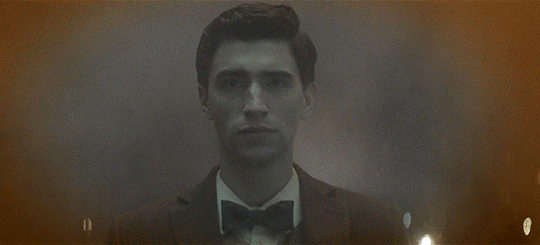
This would look so cool if it was being shown at a movie theater on a huge widescreen, but we’re not watching this show in theaters. We’re watching it on screens where this would make it look small; what they do instead retains the feel of watching something big and cinematic.
So back to the actual transition:

In breaking out of the perceived container, it’s as if it were breaking the fourth wall, an acknowledgment of the video’s format and its true container. This story is addressed to the audience in a way that the rest of the show is not, and it uses the aspect ratio to let us know that.
Spherical Lens
(I would highly recommend you read pt 1 if you haven’t already)
Edwin’s flashback is not only the sole scene with its own aspect ratio, it’s also the only scene shot with a spherical lens. Like the aspect ratio, this is a historically informed choice. Anamorphic lenses technically existed during the last year or two of Edwin’s life, but movies were not being shot on them.
How do we know that a spherical lens is being used, and how does this affect the show?
One of the quickest ways to identify the lens is to look at the shapes of the bokeh. There’s not much bokeh in the flashback, so I apologize for the intensity of my first example. But here, look behind Edwin’s head, where the lights from above reflect on the wet basement floor. They’re all circles, instead of the ovals that we get with the anamorphics.

The lens flares are also really different. Remember that the anamorphic lens flares are horizontal lines. Spherical lenses don’t do that, but they can produce lots of different kinds of lens flares. In this shot, the flashlight pointed at the lens lets off lines in lots of directions, kind of like sun rays.
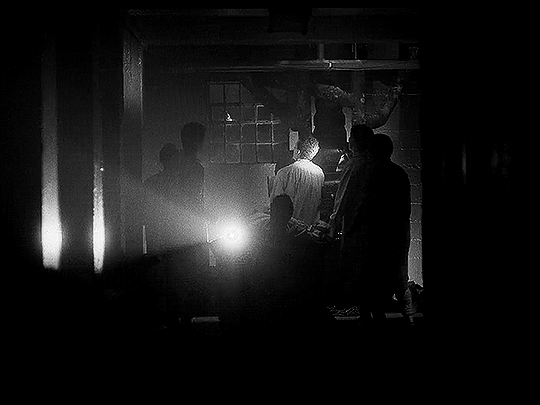
This shot has another cool flare, in much more detail this time:
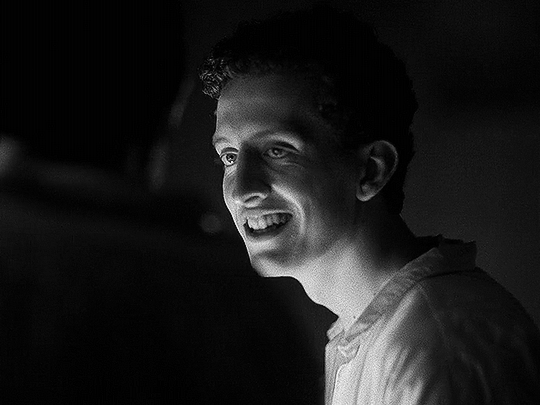
The next shot shows us more of the circular bokeh and another kind of lens flare.
For the bokeh, look at the lights on the ceiling as well as the corners of the out-of-focus architectural details (the semi-arches).
The lens flare here is the bouncing, blurry circle near the middle, as well as the brighter shape near the center bottom.
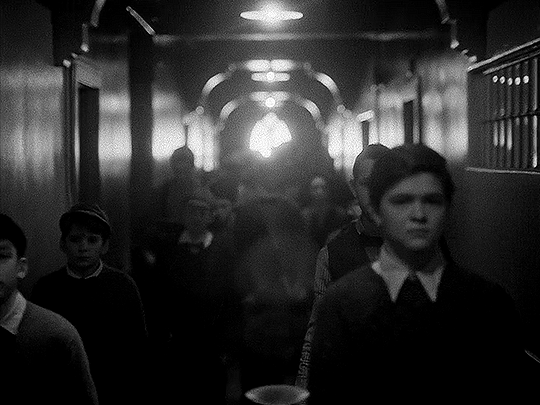
We can then look at the things that are not different, but absent when using the spherical lens: barrel distortion and focus falloff.
In this example, look at the windows in the background, as well as Edwin’s chair. An anamorphic lens would distort the vertical lines, bending them into a gentle fisheye. It would also make that chair and the lines of the window frames a bit blurry, as they’re close to the edges of the frame. Instead, the lines are straight and clear throughout the whole shot.

In this next example, not only do we get a great view of the lack of focus falloff, with clear lines throughout the shot, but we can see more of the difference in perspective and distortion of lines.
You may notice that the windows and doors are not perfectly straight up and down. But is this barrel distortion? If there was barrel distortion, the walls would curve back towards the center of the frame at the top.
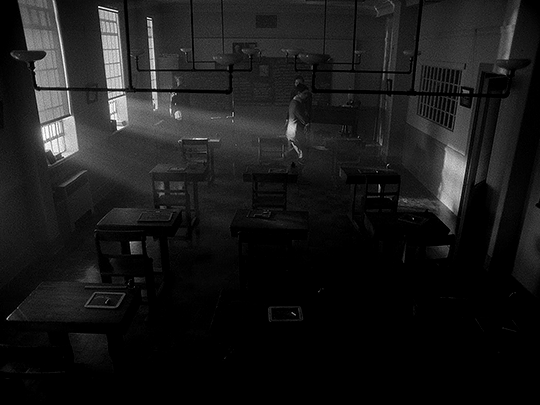
Spherical lenses are often the ‘default’ lens. They’re wonderful and used in a lot of media because they are neutral. They distort less, thus representing the world closer to how it actually is. If we consider the anamorphic lenses in the rest of the show being used to enhance the sense of supernatural and story, changing to a spherical lens enhances the sharp reality. This is Edwin, alive.
The image breaks out of its perceived container, reaching out to the audience, and then changes the lens to be more ‘real.’ In these two changes, not only do we have a more historically accurate image, but it's as if the creators are issuing a warning to us. Maybe the demon isn’t real, but bullies are. Kids can be cruel. Classmates hurt their queer peers. This is not fantasy, and this is as true in 1916 as it is today.
Using a spherical lens in this instance, juxtaposed to the rest of the show, is a dramatic shift to make, as it alters just about everything in the image. In using a less distorted picture, for this, we are reminded of reality and life and the mundane.
On Charles’ Flashback (and an experiment)
Edwin’s flashback got the Cinematography Treatment™ but what about Charles’ flashback? It’s shot with the same aspect ratio and lens as the rest of the show. From the perspective of historical accuracy, this is fine. It’s a scene that could have been shot in 1989, cinematographically speaking. The reason I suspect that it wasn’t given any stand-out look is because, unlike Edwin’s flashback, Charles’ flashback scenes are closely tied to the present-day plot. They aren’t just scenes of Charles remembering things, they are a direct result of the Night Nurse’s “memory magic.”
Maybe changing something here would separate us too much from the plot. Both flashbacks (in episodes 4 and 7) are induced for a specific purpose related to other present-day characters. It wouldn’t make as much sense to have them be standalones.
However, if I were simultaneously the showrunner, screenwriter, and cinematographer, I would give Charles a standalone flashback scene. In that flashback scene, here’s how I would shoot it:
There would be a much deeper depth of field/smaller aperture than the rest of the show, so the background would be more in focus.
There would be harder, less-diffused lighting. This would also impact the coloring, and I’d maybe add some more saturated lights.
I’d try to make an argument to shoot that scene on film (and then argue to do Edwin’s on film too).
There would be a different aspect ratio; 2.2:1 isn’t out of the realm of possibility for the 80s, but it wasn’t common, and it wouldn’t have the kind of impact I’m searching for if it didn’t change.
There are three different aspect ratios I would choose between, and the lens would change depending on my pick.
I’ve made some mock-ups for how these would look, though I cannot adjust things like bokeh and depth of focus, and I can only do so much with the lighting.
2.39:1 with anamorphic lenses (specifically Panavision lenses) This is a super standard widescreen, with a popular lens from the time. We don’t have lens info for the rest of the show, but I think they’re using Panavision anamorphics anyway so the lens may not be a change. Big, blockbuster action movies from the 80s would often be shot in this (perhaps most relevantly, Ghostbusters), and it’s a style that kind of faded in popularity in the 90s and 2000s, so it can have more of a retro look, especially if shot on film. One downside to this would be the aspect ratio change would not be as dramatic.
Movies from the 80s shot with this combo: Raiders of the Lost Ark (and other Indiana Jones movies), Star Wars: Episode V - The Empire Strikes Back (as well as Episode 4, which came out in the 70s. Episode 6 used the same ratio and did use anamorphic lenses, but not Panavision), Ghostbusters
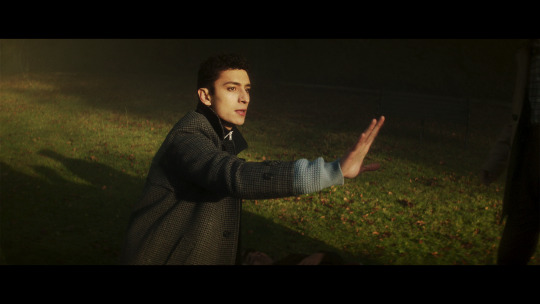
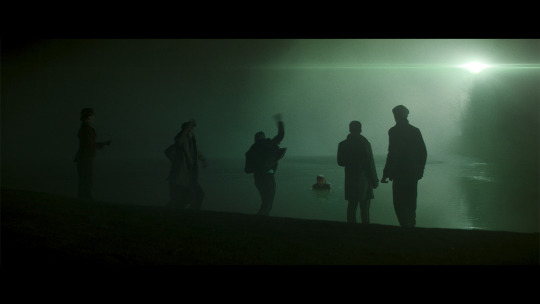
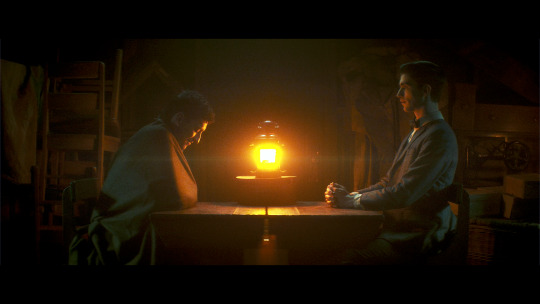
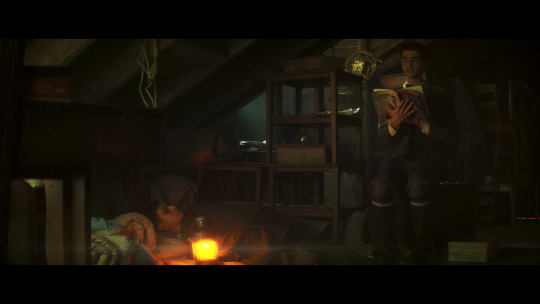
1.85:1 and spherical lenses. This is also ‘widescreen,’ but the advantage of using this aspect ratio is that we could get another dramatic breaking of the image container, just like in Edwin’s flashback. It’s an incredibly common setup, so it’s not really unique, but it would look different from the rest of the show. Given how pervasive ultra-widescreen still is today, I think a lower aspect ratio would also ramp up the ‘nostalgia’ factor a bit. Using a spherical lens we’d end up with the same sense of stark reality that we get for Edwin’s flashback as well (the warning that kids are cruel, but this time to people of color), and I like the idea of that as a parallel.
Movies from the 80s shot with this combo: Back to the Future, Dirty Dancing, The Princess Bride, An American Werewolf in London, Clue, Another Country
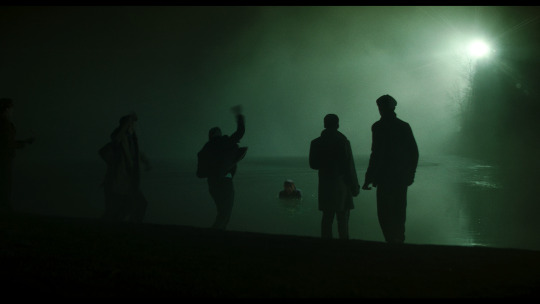
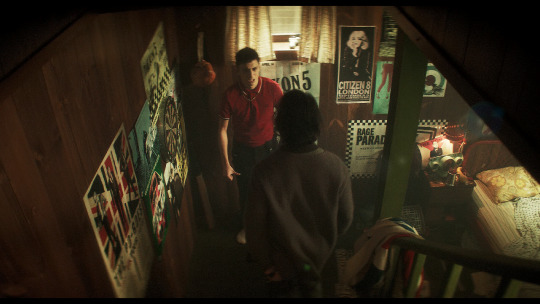
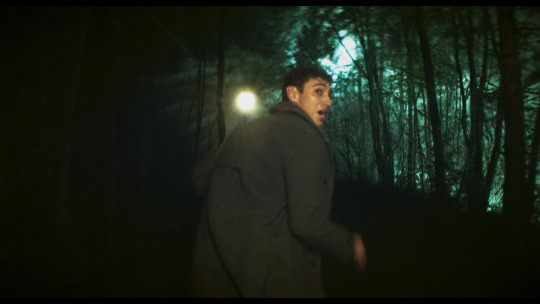
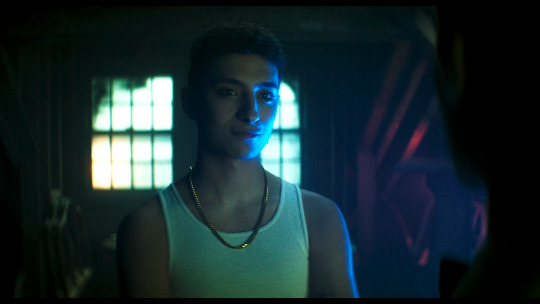
1.66:1 and spherical lenses. This is a ratio that was used widely across Europe, but has never been a common ratio in the USA. However, by the 80s, filmmakers were going for a more widescreen look so it was fading from popularity everywhere. The 80s liked widescreen, so it’s maybe not the best pick for making a scene look “80s”. However, my main motivation for this ratio is that my personal picks for the most Edwin-coded and most Charles-coded queer films are both 80s films shot with a 1.66:1 ratio. We would also get the same benefits from using the spherical lens as I mentioned in the 1.85:1 section.
Movies from the 80s shot with this combo: Maurice, My Beautiful Laundrette, Law of Desire (La ley del deseo), and an honorable mention to Chungking Express, a 90s film that really exemplifies the kind of look I'm going for here

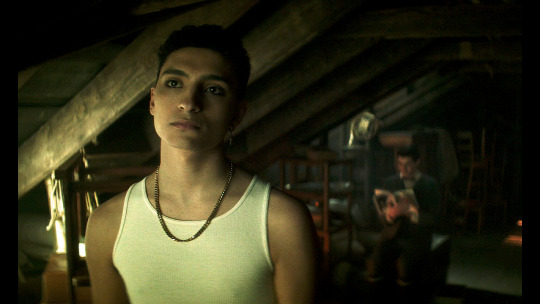
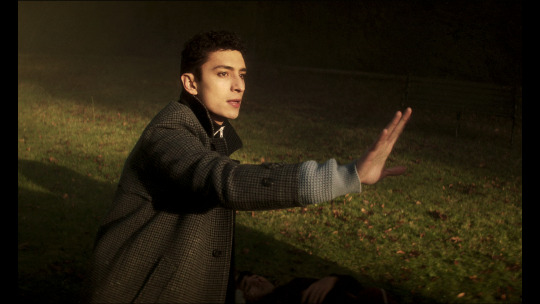
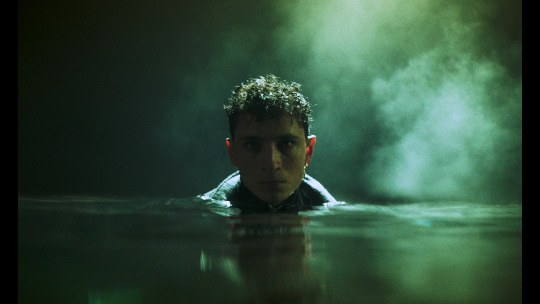
Giving Charles’ flashback a special treatment would probably do a lot to more firmly establish his character as a co-protagonist rather than a deuteragonist, which is definitely not the case but does seem to be how some people view him.
With the impact of the spherical lens and aspect ratio in Edwin’s flashback, the final two options for Charles flashback would be the closest in terms of echoing Edwin’s flashback, and would probably provide the most gravity and sense of crushing reality to the scene.
Setting a single scene (or two scenes) aside like this, with a unique aspect ratio, lens, and color grading (which I didn’t explore much for the Charles flashback), makes us consider a scene more independently from the rest of the show. Edwin’s flashback is a striking moment with a very different look, and that’s deeply memorable. It comes together to push how tragic and unjust Edwin’s story is.
—————
This concludes the planned portion of my cinematography analysis. I had a ton of fun researching and writing this (and making all the graphics) and I hope you all find this interesting/helpful/informative :)
Finally, I want to give another name drop to the cinematographers, Marc Laliberté, Craig Powell, and Pierre Gill. They’ve really nailed it from the very first episode to the last, and there’s so much intention and thought given to every aspect of how they shoot this.
#dead boy detectives#dbda meta#dbda#edwin payne#charles rowland#cinematography#dead boy detectives analysis#cinematography analysis#mygifs#dbdagifs
283 notes
·
View notes
Text
Humans are weird: The Long War
( Please come see me on my new patreon and support me for early access to stories and personal story requests :D https://www.patreon.com/NiqhtLord Every bit helps)
War’s often did not last long when fought between warring galactic powers. They often fell within one of two categories.
The first would be a short but brutal war in which one side had overwhelming superiority over their rival and would decimate them within a short period of time either resulting in the defeated offering concessions for peace or being incorporated into the victors realm as a new territory.
The second and less frequent of the two would be a drawn out conflict that would reach a stalemate at some point due to the near equal power of the opposing sides resulting in a peace treaty or more likely a cease fire that would last for a few years before resuming hostilities.
These two outcomes were the most frequent as with the age of space travel often came great leaps and bounds in other forms of technology; many times said technology being diverted to respective military industrial complexes.
Weapons that could carve up continents from orbit or snap starships in two like twigs left little in room for anything else.
Humans did not share this notion.
In quite a contrast to the standard norm human military planners also considered lengthier drawn out conflicts. Data sheets and computer banks were filled with projections for supply consumption, industrial production capacities, troop conscription rates, and even the designated planetary ration levels that would be acceptable before general population revolts within their own territory.
This practice was first demonstrated when conflict broke out between the Drumengi and the Terran Republic after a series of trade disputes resulted in the Drumengi seizing several dozen human trade vessels and demanding a ransom for their return. This was a grave insult and the Terran Republic responded the next day with an open declaration of war.
While the Drumengi did not have a sizable fleet, they had invested in a wide range of defensive orbital installations that dotted their territory in what was known as the “Halo of Iron”. No fleet had ever been able to breach the defenses of the Halo and so previous wars had gone for little more than a year before a peace treaty was negotiated. The Drumengi expected as much and planned to force humanity to the negotiation table.
It was unfortunate no one had informed the humans of this plan as the terran’s had already devised a plan to crack the halo.
Establishing a vast network of relay stations, automated satellite weapons platforms, and mobile fleet waystation’s that were brought in and placed along key trade routes into Drumengi territory, humanity established an iron halo of their own. Once the human ring was completed warning beacons were activated and a message was broadcasted in every language declaring the territory an active warzone and refused passage for any ship to try and cross through it.
Initially the Drumengi were inclined this was the prelude to a massive invasion fleet and prepared themselves, but as the months turned to years still no attack came. Human fleets patrolled the surrounding systems and intercepted all ships that tried to breach their lines with the help of the relay stations that were constantly scanning the surrounding space for ships.
Three years passed and soon every ship learned to avoid Drumengi space for fear of human retaliation; and that is when the Drumengi learned the true plan of humanity.
They never intended to besiege their defensive ring in some full frontal do or die charge. Instead they had formed a blockade that now was choking the very life of the Drumengi economy month by month.
It was never intended for the war to last more than a year, two at max, but now humanity was still showing no signs of relenting as the war dragged on to the fourth year. Critical supplies had not been stored in sufficient quantities for an extended war and while the public was assured of an eventual victory, Drumengi planners were beginning to panic. Worlds within Drumengi space were reporting that their stockpiles had dropped 32% since the war began and were increasingly demanding to open negotiations with the humans.
With little offensive capabilities the Drumengi were forced to sit behind their iron halo and continue to wait out the humans. Several delegations had been sent to other powers to open up channels and begin laying the ground work for peace talks, but each time they were informed that the talks were stalled by human counterparts who proceeded to drag their feet over every minor detail. One delegation went so far to report that a human diplomat would not accept any document unless it was written with a “Ballpoint Pen, color blue”. No one had any idea what that was exactly and even after researching it the device took another three weeks to be shipped in only for the human to reject it again saying that they had imported red pens instead.
The war dragged into the fifth year and supply levels had reached critical across the entire Drumengi domain. Supply levels had decreased by 67% for most worlds while fuel levels now were at a critical 13%. Travel was limited to military personnel, government officials, and what limited transportation still remained. Food riots had broken out in several major metropolitan areas on numerous planets and were becoming increasingly difficult to put down. In some cases the magistrates sent to neutralize the riots switched sides and joined the rioters, beckoning the military to get involved as well. That did little to settle the matter however as then the government worried how long it would be until the military switched sides as well.
With heavy hearts and empty bellies the Drumengi leadership finally came to humanity directly and offered to surrender. No terms were asked for save the resumption of trade and the dismantling of the human ring of iron.
The humans agreed to the first measure, but denied the second. Their ring of iron would remain, as a reminder of how easily humanity could cripple them again should the Drumengi ever show their hand again. They also insisted on reparations for maintaining such an extensive grid and exacted a high sum of credits as well. The Drumengi were outraged at this. They were told not only to surrender but to also pay for their imprisonment? The government would be overthrown within a fortnight when the general population heard the news.
Their pleas fell on deaf ears as the humans reiterated their demands once more.
As they had planned ahead for their long war, so too had they planned for the end result. They had changed the nature of the war and had steered it to the point where either outcome would be in their benefit. If the Drumengi agreed to the terms the current government would collapse in on itself as the general population railed against humanities demands, but if they refused their supplies would run out at the general public would once again violently rise up across their entire domain and their territory would become nothing more than mere pocket kingdoms for despots and criminals.
Regardless of the choice, the long war would finally be at an end.
#humans are insane#humans are weird#humans are space oddities#humans are space orcs#scifi#story#writing#original writing#niqhtlord01#war
131 notes
·
View notes
Text
Adonis Sports Cup & Olympics Festival - Alpha Football - Post-game I
The nature of pigskins evolved as the years went on and generations continued to grow in stature and size, and over time, football had to be split into two tiers--regular football, for your average Joe, and alpha football, for the adonises that were becoming more and more the norm in the nation.
Football truly faded from the limelight and was replaced by alpha football in every sense, because not only were the men even brighter examples of muscular and masculine perfection, but the games were so... so intense. The tackling, the grunting, the barreling into each other, running forward at full speed, enormous feet digging into the dirt as they were forced backwards by the 18-wheeler-opponent shoving into their chest... and not to mention the way they looked walking off the field--it might as well have been pouring rain with how their hair was plastered to their heads and the sweat was literally dripping off of them. Needless to say, protective gear was scrapped due to just how muscular they all were, so jerseys were the most they'd need if they chose not to play bare.
With the games being so intense, post-game rituals were important fixtures in the flow of the sport, and the foundation spared no expense in making sure everything was catalogued, documented, and broadcasted to ensure that being an adonis was the most desirable thing possible. Cameras were set up in the locker rooms and the shower stalls, these videos relaying right after the games on all major broadcasting stations, and as you might have expected, the viewer count never dropped.



















165 notes
·
View notes
Text
Fundemental Cultural Misunderstanding
Can I just say that there is so much humor potential in Star as far as cultural misunderstandings go.
Try this AU on for size.
-Note:Though it is not necessary for this idea, it is important to me for you to know that in this world Anakin did not slaughter the Tuskens. He reached Shimi in time to save her and his focus was getting her to safety. Thus his relationship with Padme is much healthier.-
Anakin on a fundamental, and somewhat deliberate, level misunderstands some parts of Jedi culture. He believes that Jedi cannot get married. In this world, this is not true.
Marriage in this Jedi culture includes a marriage bond between all parties that, if not set up correctly, can do a fair amount of damage (and even when set up correctly doesn’t provide more than a sense of the other person's physical condition and emotions; rarely bonded might be compatible enough that that they can track each other through the bond). This is particularly true if one of the parties is not Force sensitive, or one of the parties is particularly Force Sensitive. So there is a lot of pomp and ceremony around getting married in the Jedi tradition to make sure the bond is correctly set up. Also consent is such a large portion of Jedi culture, so extra pains are taken to make sure non force sensitives understand what such a bond might mean…to the point where it freaks out most non force sensitives. This all culminates in, by the time of the prequels, most Jedi just don’t get married.
-It should also be noted that marriage as a legal institution and marriage as a cultural institution are actually two very different things, though they are often conflated. Marriage as a legal institution means absolutely nothing to Jedi, and in fact many cultures, because the rights granted by the legal institution of marriage either don’t apply to Jedi or are covered by other Jedi related laws.-
This is also misunderstood by the Galaxy at large. Also, because of this misunderstanding most cultures do not discuss their marriage customs with Jedi, sure it might come up organically but no one thinks that this is a cultural norm that the Jedi need to know. Which means as much as the Galaxy misunderstands the Jedi’s marriage customs, the Jedi misunderstand most other cultures' marriage customs as well. In fact the Jedi, through generations of a benign misunderstanding, believe that most cultures will not discuss their marriage customs with Jedi, so all they can go on is their own observations.
Picture if you will, little padawans vibrating their way into the Archives, up to the nearest archivist, who drops everything because the little Padawan wants to report that they ATTENDED A WEDDING.
This leads to the archives being chock full of conflicting information about the various marriage customs throughout the galaxy, because anything that happens at a wedding now becomes a TRADITION of that planet, even things might be just a preference of the people marrying, or even a happenstance. The Jedi have all collectively agreed that they are just gonna roll with it, no matter how strange the custom or if it contradicts anything else (It is not like they can get information directly from the source after all).
Now when Anakin got married to Padme, he thought that Jedi cannot marry. He thinks that his elopement would have to be a secret. He does not realize that he broadcasted his joy at marrying Padme to every Force Sensitive in the galaxy (no seriously, there are Force Sensitives on planets that don’t even have space flight yet, on the other side of the galaxy that felt an abrupt and incomprehensible wave of utter joy-some of those were physiologically incapable of feeling joy like near humans and had to lay down for a while). Also, not that he realized it, the part of his Force Signature (which Jedi are taught in the creche how to read) that deals with identity flashed with the equivalent neon lighted dashboard in Times Square that he was ‘Mr. Padme Naberrie’ from that point forward.
So when Anakin leaves on a mission, unmarried, and comes back very married, but clearly hiding it, it is quickly noticed. But no one thinks that it is Anakin who does not trust them. Of course not, he is family. They decide that this must be some heretofore unknown Naboo marriage TRADITION, elopement followed by hiding the marriage.
No one, not a single jedi in 10,000, thought to ask Anakin directly.
Several Archivists promptly write some very well written papers on this tradition, and how it fits into their other knowledge, basically filling in the gaps to create a tradition out of whole cloth (even though they are acting in earnest).
The war still starts, with all that entrails. But every Jedi knows about Anakin’s ‘secret’ marriage. The little ones all giggle about it. Most are eagerly waiting for the tradition of hiding to be complete, because surely ‘The Man Without Fear’ and his wife would also want to marry in the Jedi tradition. There was so little to be excited about these days that everyone bought into this notion, even those that had long decided they would not go through the process of the Jedi Marriage.
The children in the creche insist on making decorations for the eventual Jedi Wedding. In fact there were multiple sets of decorations, depending on where the happy couple wanted the ceremony performed. Just rooms and rooms of decorations and drawings and artwork of all kinds.
The High Council, including Obi wan, started researching to make sure they knew all the steps and traditions for the Wedding backwards and forwards whenever they had the chance. The last time a Jedi Wedding had been performed was 200 years earlier and enough had happened since that even those who were alive during that time were a bit fuzzy on the details. They wanted to be ready to support Anakin and Padme in any way possible. Padme’s biometrics are quietly added to the Temple’s banks; ready to be activated as soon as the couple is ready. A plan is put together so that Padme can be quickly evacuated if there was an active threat against Anakin specifically, or Jedi adjacent beings in general.
And the Archivists are practically having duels to see who would get to speak to the happy couple once the period of hiding is done. There is hope throughout the archives that maybe, if they ask really nicely, Padme would be willing to answer a few questions on Naboo marriage traditions (All the Archivists want to learn so badly, all they want to do is be able to learn. Can they please learn).
Perhaps if it had gone on much longer someone would have cottoned on to how stressed this secret was making Anakin. Maybe not. Perhaps this world still could have ended in unimaginable tragedy.
Perhaps in another world like this. In this world, we look to humor instead of horror.
A little over a year into the war several of the youngling clans, ages ranging from about 4-6, got to go on a tour of the Senate. One of the younglings (Age 4, species was Sabetue and was genderless) got separated and couldn’t find a clone guard or anyone they recognized. They were wandering and scared, but somehow made it up to the level where Padme’s office is. And the Youngling recognized Padme’s Force signature as Master Skywalker’s wife, so they knew they would be safe with her.
So now Padme has a small Jedi child in her office. Thankfully she was not in a meeting. She manages to get a hold of the Guard, who send up two of creche masters, who had been beside themselves with worry. While in her office the child said things that made it clear that the child knew about Padme’s marriage to Anakin and how they couldn’t wait to see how pretty she would be in the Jedi Wedding. One of the Crechemasters very gently reminded the child that Anakin and Padme might decide not to get married in the Jedi Tradition, that it had to be their choice and followed up with:
“And if we forced them…”
The child piped back with a solemn “we would be meanies”
One of the creche masters brought the child back down to the group while the other remained behind. First to thank Padme for finding their lost child. Then also to apologize for the child breaking the Hiding Tradition, expressing a hope that this would not have any negative impact on Padme’s marriage.
The Crechmaster seemed so proud at saying ‘Hiding Tradition’ that Padme did not have the heart to tell them that she had no idea what they were talking about (they are very proud of remembering what the Archivists were calling this tradition). They continue to have a brief conversation where Padme learned a number of things:
The Jedi, every single one of them, knew about Padme’s marriage.
They are all, every single one of them, actively supportive instead of the at best disapproving she thought they would be.
The Jedi somehow believe that Padme and Anakin are hiding their marriage over a Naboo Tradition
There are rooms full of crafts created specifically to decorate for her wedding in the Jedi Tradition created by hordes of earnest younglings.
The Jedi are very into consent.
Anakin is not due back on Coruscant for another week, and during that week Padme made discrete inquiries (oddly enough these are actually discrete) that told her nothing important about what was going on and driving her to distraction. So Anakin comes back to Padme nearly screaming at him ‘Why do the Jedi think we are hiding our marriage over a Naboo tradition?’
Anakin very much does not know but suggests that they ask the Chancellor (Anakin has very much been conditioned by the Chancellor to turn to him first in any instance of confusion).
Padme stares at him for a moment, tells him that is a stupid idea and to call Obi Wan.
Anakin does not want to call Obi Wan. He does not want to tell Obi Wan about their marriage and get in trouble.
Padme stares at him with the dead eyes of someone dealing with too much ridiculous information at once, then says ‘Call Kenobi’.
Anakin obeys.
Obi Wan comes over, they all sit down and Padme very calmly tells Obi Wan that she and Anakin are married. Obi Wan immediately begins radiating blinding excitement. He congratulates them and starts to ask about having a Jedi wedding before deflating again and asking if not pretending he was surprised would ruin anything. He offers to go out and they can do it again, he can pretend to be shocked.
Padme reassures him. Anakin starts to express his surprised (in a way that would have made it really clear about why he was hiding his marriage) but Padme quickly interrupts him, asking about Jedi Wedding traditions and lets Obi Wan ramble really happily about the research that the High Council had been doing to make sure they can recreate those traditions if Padme and Anakin want.
Obi Wan leaves with a promise that Padme and Anakin would come to speak with the High Council to make sure all the legalities (making sure everything is set up so that Padme can come and go as she pleases at the temple, and have a login to access the Archives, and would it be possible for her to come in for a baseline check up so that medical their records are up to date) are taken care of. As soon he is gone Padme grabs Anakin by the collar and goes ‘we can never tell them’
Anakin goes ‘what?’
‘We can never tell the Jedi why we were hiding our marriage. I’ll contact my parents as soon as it is morning on Naboo. They can back us up. We can say it is an old family tradition to hide the marriage for the first year. It isn’t used much, but after being in the public eye and with the War I was feeling superstitious, ok?’
Anakin goes ‘What, Why?’
Padme shakes at the arm in her hand, ‘telling the other Jedi that you didn’t trust them with your marriage would break their hearts. Do you want to be the reason small children are crying?’
Anakin looked far too considering for Padme's piece of mind, and what little sanity she had left.
‘Let me put it this way, do you want to be what finally break’s Obi wan’s heart? That man was vibrating with excitement to celebrate our wedding so hard I could feel in the Force.’
Anakin deflated, ‘Oh. No.’
Padme’s parents laugh their ass off that she needs to create a long held family tradition because she doesn’t want to admit to the Jedi that she had thought they would react badly to her marriage. They agree to do it.
<Somehow this does derail Palpatine’s plans. Personally I want it to be in a way that leaves people unaware that he is a Sith, so for the rest of his life he needs to maintain the kindly old grandpa look and suffer for it- maybe something that means he has to actually live a clean life; no more crime or torturing for him.>
Twenty four years later Obi Wan helps Leia Naberrie meet up with Han Solo in order to Elope in the long held family tradition (Bringing with them only R2 to follow the actual tradition closer than they realize). Obi Wan very carefully leaves before Han arrives, so that he can truthfully say he does not know that they eloped.
Leia’s twin Luke does not need to elope, as he followed his Uncle Obi Wan into the Jedi (an unrelated note he also followed Obi Wan into the mindset of ‘Why Monogamy when Harems naturally occur’-From that day the war ends Obi Wan has no less than three clones with him at all times; he also appears to have a lover, a friend, or an antagonist that he has weirdly sexual dialogue with on every planet he visits. Or Hondo Ohnaka, who has a category all his own. The years that Boba Fett comes to the holiday meals as one of Luke’s plus 6’s-He couldn't choose just one and no one would think of making him- are among the most awkward of most of their lives.)
#star wars#star wars the clone wars#fanfiction prompt#star wars au#obi wan kenobi#anakin skywalker#codywan#bamf obi wan#no order 66#Obi Wan has a Harem#the clone wars#The Clones Love Obi WAn#anidala#Anakin does not go to the Darkside#elopement
531 notes
·
View notes
Text
Boys Be Brave [EP.5] // Translation notes
I'm back with my - I guess?? - already weekly analysis of something Gaga subs might've missed in this show. Because apparently, the silly show got deeper and I'm staying here until the very end :D

First of all, I was curious and checked whether there is anything about Kiseob's illness, and there is! There are two diagnoses:
상세불명의 심실중격결손 상세불명의 심방중격결손 Unspecified Ventricular Septal Defect, Unspecified Atrial Septal Defect
I am not a doctor definitely, but quick googling told me it's a heart defect (also called as 'a hole in the heart') which can have symptoms of heart malfunctioning. Which would! Explain even more! Why Kiseob has wrist watch that always measures his pulse and why on several occasions he was wondering why his heart was beating so fast next to Jinwoo (well, one for obvious reasons and another one is this).
And it's something you have since birth so he's been dealing with medication his entire life. Which would also explain further - after the scene with his sister - why the urge to be a people pleaser is so serious and so ingrained in him.
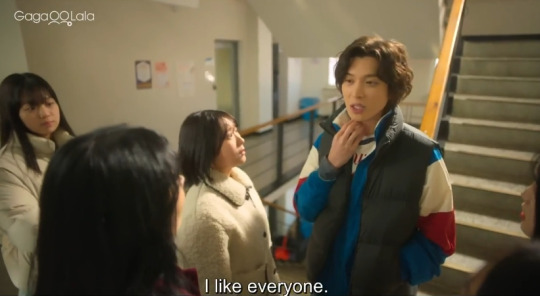
Another interesting language detail I noticed in this scene. Kiseob says "That's why I just agree to anything" but it doesn't translate well to english, because the verb 좋아/좋아해 can mean "I like" (eating medicine) and "I like (the idea)/I agree". So first he started lying that yes, he likes taking medicine, and that transferred to him saying that yes, he likes this, he agrees with this (whatever that is, anything he is proposed with)
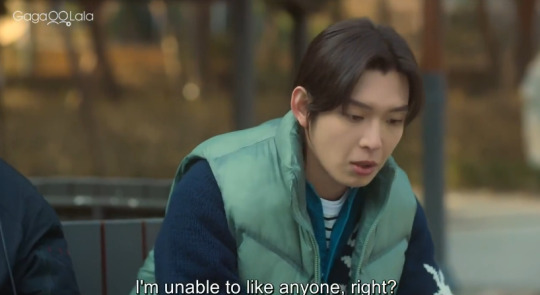
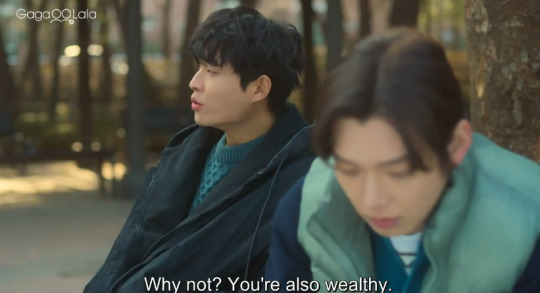
"I cannot like anyone, right?" "Why not? You're a bastard with a lot of money"
This phrase references all the previous phrases that other people used to describe Kiseob, but Balgeum doesn't sense the real problem of his friend because the phrasing is general, it can also mean 'I have no chance of loving someone', and that's why Balegum thinks it's just Kiseob having low self-esteem or something. And also to him having money = being able to love, letting himself confess and date the one he loves, so of course, that's his answer. Kiseob has a lot of money, why wouldn't he confess to Jinwoo if he likes him?
But Kiseob can't because he doesn't even know his own feelings, and everyone around tells him he doesn't have the ability to love someone.
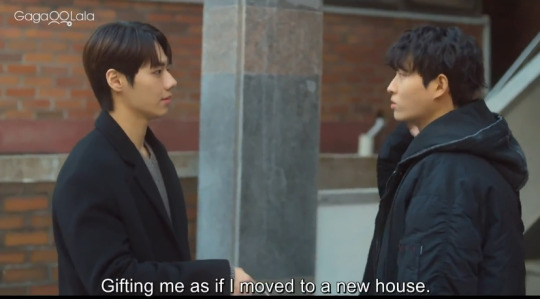
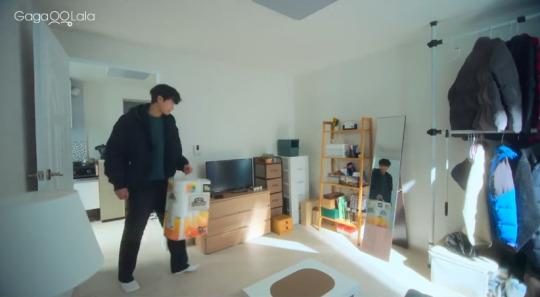
"Giving me (toilet paper) as if I moved to a new house"
Now, I cannot be the only one thinking years ago why the hell Koreans give each other huge packages of toilet paper when they visit someone xD But this is also a cultural thing!
When your friends move to a new house, you are supposed to come with gifts and usually with very practical ones, like toilet paper (very common gift). Rich friends can give you coffee machines or humidifiers or something like that. In my country, when you visit friends (not moving houses but still), you usually bring some desserts or food to have with tea. So for some countries, toilet paper is a norm :D
Balgeum has been living in his small apartment for a long time but it's the first time Inho visits his house so he's giving it a gesture of respect (but still an awkward one).
[Interrupting my broadcast to scream about cuteness and awkwardness of Balgeum x Inho AAAAAHHHHH Now back to the schedule]
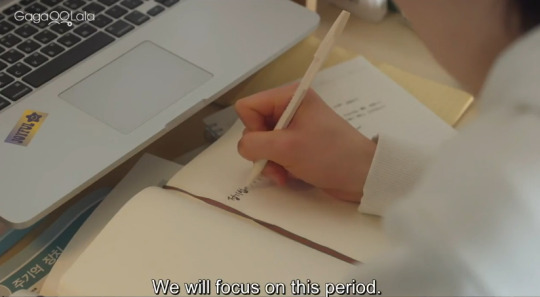
...No, we will definitely focus on scribbling over Jung Kiseob's name for 100th time, absolutely distracted from any historical knowledge going in the background ^^
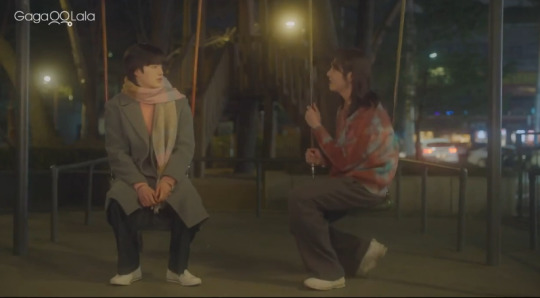
Oh! By the way! I remember being surprised that, apparently, some people on social media were uncomfortable with Kiseob seemingly 'feminizing' himself to be likeable by Jinwoo. Let me tell you that no, Kiseob doesn't do that at all!
There is nothing truly that indicated that he wants to be a ideal girl for Jinwoo (who has non-gendered perfect type list as I mentioned in my previous translation notes post!). He doesn't even use typical school-girl aegyo on Jinwoo (aka acting cute), maybe a tiny bit but it's not typical and it's not usually in his language at all. He talks gently and softly a lot! But he doesn't add typical cuteness in the way he talks (like there's no pouting, mumbling words and ending sentences with -ung).
I talked about dress = one-piece = jumper suit being the same in Korean but Kiseob literally only follows what Jinwoo wrote about a person he likes (not girl). As I described it, "he's using loopholes in Jinwoo's specific list in a true himbo way" :D He doesn't really do anything girly and doesn't pretend to be a girl as I can sense.
And I don't think I need to clarify another time, but falling in love during first snow/first sight is one of Jinwoo's list. Which Kiseob already fulfilled but he doesn't know that, and he just saw Jinwoo being with Hyejin witnessing first snow, which was the last straw for him to admit his failure and give up pursuing Jinwoo.
By the way, Koreans really think the first snowfall is a romantic event, like there are saying you'll fall in love with/be happy dating with someone you'll be with during first snow^^ It comes up in many Kdramas.
#boys be brave#boys be brave comments#kbl#korean bl#dropthemeta#dropthemeta kbl#learning languages#korean language#translation notes#language details#lost in translation#jinwoo x kiseob#inho x balgeum
87 notes
·
View notes
Text
It's Imogen's turn now.
[I'll preface this by saying that I usually hate when tv or film adaptations of books add new characters, and I'm immediately biased against them when they show up on screen (hi, I'm the problem, it's me). I'll admit I felt that way about Imogen at first. But Alice is such a genius, and they wrote Imogen into the storyline in such a way that she feels not just essential to the plot, but also to some of the other characters' development. And to top it off, this girl gets one heck of a character arc. For this post, I'll focus on just one aspect of her journey: her gradual movement from loneliness to connection.]
At the beginning of season 1, Imogen is one of the few girls who hangs out regularly in front of the boys' school. On the surface this could look like a typical way to attract a boyfriend within a known and relatively safe group. But, unusually, she's never seen interacting with anyone else in any meaningful way, the first clue that this group might be all she has. The other boys in the group seem to engage her minimally, and only mention her in terms of her attractiveness and as a potential match for Nick. Compared with their indifference, Imogen can clearly see that Nick is a good choice--attractiveness and rugby king status aside, he's a kind and attentive part of their friend group, and she's known him a long time, even if only superficially. Cue an awkwardly aggressive pursuit that includes:
A lack of respect for Nick's privacy;

Nonconsensual touch;


Inviting herself into his life in public where it's hard for him to say no, then broadcasting an inaccurate relationship status to their friends;


And petty, self-protecting revenge for perceived rejection.

None of these behaviors are particularly pleasing to watch happen, especially when we know everything Nick is struggling with internally, but they are very typical of someone who desperately wants connection but doesn't know how to achieve it in a non-superficial way. Imogen is genuinely fond of Nick, and even amid all of the obnoxious but socially acceptable ways she tries to hold his attention you can see glimpses of that fondness and care (letting him off the hook when he clearly doesn't want to say he likes her back at the dance comes to mind). The fact that she still pursues him the way she does doesn't make Imogen a bad person; it shows us she’s a lonely person, particularly vulnerable to the currents of peer pressure and expected societal norms, long before she admits in season 2 that she doesn’t actually have that many friends.
And then, we get the hugely important conversation in the park with Nick (and Nellie, the emotional support dog we all need). It must be said that Nick is choosing to share a really complex part of himself with Imogen here; he could easily have left it at “I don’t like you like that.” But instead, he takes this moment when Imogen isn’t distracted by posturing or fitting in or flirting to tell her what’s really going on in his mind. On some level, he trusts her with this truth—not the whole truth, obviously, but a big part of it—which tells us he recognizes that beneath her façade Imogen is a caring, trustworthy, and kind person. Naturally most of the focus in this scene is on Nick, but this talk also marks the beginning of Imogen's journey toward authenticity. It starts with the realization that she feels at least some of the same things Nick is feeling about being afraid to change and not fitting in, followed by a shift in her perspective on Nick himself.

Once Nick is no longer a romantic prospect, there's room for her to consider him as a whole person and a true friend, not just someone she "hangs out with every morning." She can begin to see and value the things about him that are intrinsic parts of his nature, rather than the outward trappings of just a datable boy. Imogen can let down her guard with him because he let his down with her first. She can give more of her true self to this friendship because Nick has no expectations of her beyond that she be kind and be herself. There are no popularity points to earn, no hoops to jump through, no fear of rejection. So now, she protects him from the scorn he might have received from their friend group by saying the decision not to date was hers. She begins respecting his personal space. She cares for and observes him on a deep enough level to understand at least a bit of what is happening when Nick takes Charlie off the field at sports day. She’s learning what it is to both be and have a real, authentic friend, maybe for the first time. This helps her to view other people in her life through this more discerning and nuanced lens as well.



Clearly Nick has grown to appreciate Imogen's friendship on a deeper level too, since she's the first person from his old friend group he really wants to come out to and tell about Charlie, so much so that he and Charlie make a fairly elaborate plan to create a safe space for him to do so. The sleepover at Charlie's house is another quiet watershed moment for Imogen, because Charlie's friend group welcomes her so unreservedly. They might be a little surprised to see Imogen there, Tara and Darcy may have not had the most positive feelings toward her before, and the rest of them might have some lingering reserve based on her attachment to the Harry cadre, but... They put all of that aside and draw her in with warmth and enthusiasm, partly because that is just the kind of lovely people they are, partly because Charlie and Nick are implicitly vouching for Imogen, and partly because when Imogen lets her guard down, when she's not trying to impress or flirt or maintain a certain image, she's quite lovely and fun herself.


Nick has been making a parallel journey toward connection and true friendship, but in a slightly different way. While Nick actively seeks points of connection by using his emotional intelligence and intuition, Imogen journeys into deeper friendships by enjoying the genuine kindness of the people in Charlie's friend group enough to be herself around them. She realizes that there are people who do like her just the way she is--a novel experience for her.
Of course, this is a gradual evolution for Imogen, so it doesn't all change overnight. She still spends the bulk of her time with her old friend group, who often leave her alone, and her ever-present desire to be liked and loved draws her into a relationship with Ben, who uses her in the worst way.

When she begins to suspect that Ben cares less for her than he should, that perhaps he’s even using her to get at Nick and Charlie, she starts to pull away. She recognizes that her true wants and needs are speaking more loudly than the old desire to have a boyfriend or to be part of the more popular group. She’s listening to herself, finally.
She starts spending more time with Charlie’s friend group, with people who appreciate her sunshine personality, her quirks, her big smile, who listen to her problems and give her honest advice. People whose company she enjoys on a complex level.

Once she has people in her life who accept her the way she is, Imogen can finally begin to accept herself, see herself, and value herself. Which leads us to this truly phenomenal moment, Imogen’s catharsis, her break for freedom from not only Ben's manipulations and toxicity, but the suffocating pressure of being someone she's not.

This must have been simultaneously liberating and terrifying for Imogen, but now, when she has to be brave, she has true friends to bolster and support her. She's not alone anymore.


And then, then, we get Imogen's final layer peeled away, the moment when she looks deeply enough into her true self to see this:


Imogen's self-realization is so powerful and, I think, just beginning. We are ready for season 3 Imogen.
#imogen's prom dress SLAYS#i love imogen but the hair mussing scene still makes me die inside#also--“chirpsing”--please kill me#heartstopper#heartstopper netflix#heartstopper series#heartstopper alice oseman#osemanverse#alice oseman#imogen heaney#rhea norwood#nick nelson#kit connor#charlie spring#joe locke#nick x charlie#nick and charlie#narlie
58 notes
·
View notes
Text
Alastor - Historical Trivia And Headcanons

Alastor was a mixed-race Creole man living in New Orleans, and was in his 30's/40's when he died in 1933. We don't know much else about him, but historical context can provide us with possible additional details:
The population of New Orleans in 1930 was 458,762, more than it is now. 27.2% of the people were black, 3.1% were foreign-born, and roughly half of America's bipoc population was unemployed thanks to the Great Depression. New Orleans' original Francophonication was still strong, and it was common to run into locals who only spoke French dialects (Cajun French, Louisiana Creole). The city has had a huge Chinatown, a small Little Italy, and multiple other districts known for their immigrant African/colonized French cultures.
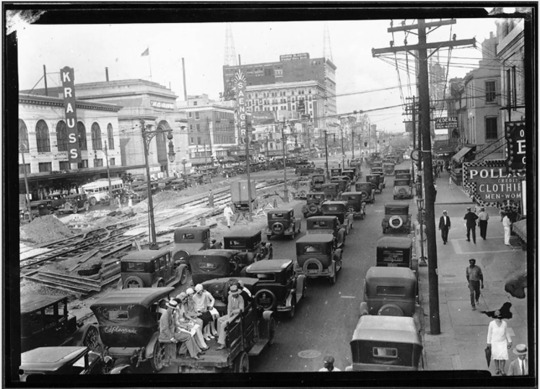
The Jim Crow laws were heavily enforced, as was the 'One Drop' rule. If Alastor was a mixed race black man, he would not have been able to attend a white school, use the same public transport, and would have shopped at black-local stores and restaurants under threat of violence. If he was mixed with any other race, some Jim Crow laws didn't apply, but state or city laws might specify differently.
Just because Alastor wears a suit, it doesn't mean he was rich in life. Radio personalities often didn't earn a fortune. Unless he owned his own broadcast, he was paid by a private company for long shifts of hosting music, news, and radio plays. In 1930, 40% of households owned at least one radio, which means that a popular radio host would have been easily recognized.
If he was in his late 30's in 1933, he might have fought in WW1, so long as he was over the age of 21. Some cities gave veterans small benefits, or encouraged the community to give them jobs. This often did not include veterans of color.
New Orleans was famous for being one of the least Christian cities in America, thanks to its unique immigrant and slave population. Haitian-based faiths and practices (such as voudo), indigenous cultures, Asian Buddhism, and atheism were common. But Christianity was still the official, law-enforced religion. Schooling involved reading the Bible, laws were sworn to Jesus, etc.
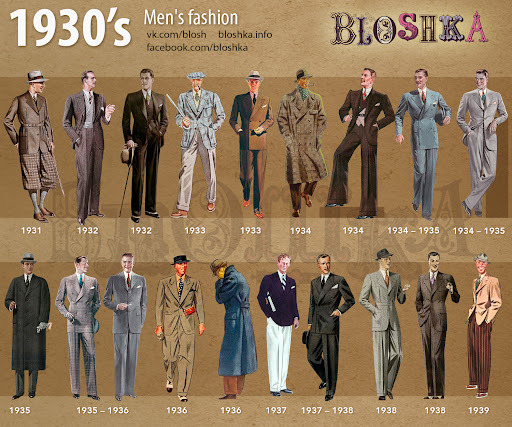
Alastor's outfit in Hazbin Hotel isn't very accurate to real-life American men's fashions of the time. Back then, deviating from the norm with the smallest detail would have stuck out like a sore thumb - like his white-lined lapels. Men always wore a hat. They were allowed to go without a waistcoat, but not a jacket. Belts were becoming more popular than suspenders. The silhouette was bulkier than the slimmer, Italian cuts of our modern times, especially the pants. Hair was kept short, and oiled down in a side part. Americans preferred the clean shaven look. Ties were essential unless you were a blue-collar laborer. Colors were almost universally muted neutral tones for everyday wear. The most colorful textiles for men were sporting outfits, like a tennis jacket.
If Alastor was a middle-class single man, he likely would have lived in an inner-city apartment, in an ethnic neighborhood. He probably didn't own a car, and took public transit like the streetcars. If he owned a house, it would likely have been an inheritance, and even the more opulent houses of the time would have looked small and plain to our eyes.
Because of the Great Depression, unmarried men were becoming the norm, rather than the exception. Men of the community who were sought after but remained single were suspect to gossip, but less ire than you might think; in the '30s, American queer culture was going through a very sharp revival, escaping the rigid Victorian era and before the puritan 40's/50's. But as a mixed-race man, it may have been illegal for a white woman to marry him, as the Jim Crow laws forbade the marriage of white people and Black/Asian people.
A middle class city household would have had electricity, gas heating, indoor plumbing, but may not have had running taps or a gas stove. Even with decent means, Alastor might have been using a potbelly woodburning stove, a dry sink/washbasin, wooden bathtub, and did his own laundry instead of sending it to the neighborhood laundresses. He may or may not have bothered with an icebox. Fresh groceries needed to be cooked and eaten soon, as things like pasteurized milk or store refrigeration wasn't a thing.
If he had enough money, then he almost certainly hired maids or other servants. Whether the maid came over just once a week, or did the shopping and laundry every other day, hired help was much more common back then, especially if he had no wife.
The most popular musicians in 1933 were Bing Crosby, George Olsen, and Leo Reisman. As you might have noticed, it was trendy for the lead singer to be backed by an orchestra, not a 'band' of just four other people like today. The most popular radio shows were Dick Tracy, Sherlock Holmes, and Doc Savage. They were recordings the radio station would buy and then broadcast, or sometimes the actors were live on the air. The radio host was usually not the journalist - the production team was responsible for writing his script.
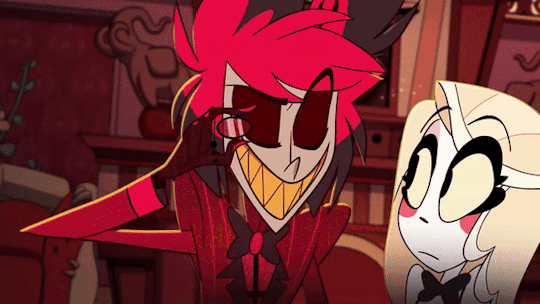
#alastor#alastor the radio demon#hazbin hotel#hazbin alastor#alastor headcanons#hazbin hotel headcanon
116 notes
·
View notes
Text
letterboxd users SHOCKED, i tell you, to find out that a movie serves an example of what it criticizes without it being overthrown at the end with the power of Just Saying No
letterboxd users absolutely flabbergasted that a movie underlines its point about a toxic social norm with filmography, instead of having characters say they're gonna do a Toxic with their mouth
#the POINT is that we're trapped in toxic social norms we're powerless against#this is not a movie about fighting social norms it's a movie about the social norms beating the shit out of you#just more literally than they do in real life#so that your painfully literal sensibilities can get the point#''feels cruel to its main characters for trying to exist in a system that uses and discards them#while being totally unconcerned with the hovering judgments of the male avatars of that system''#oh boy! IT'S ALMOST LIKE IT'S TRYING TO SHOW THAT THE SYSTEM CRUELLY USES THEM WITHOUT REPERCUSSION#broadcasting my misery#the substance
8 notes
·
View notes
Text
Demi Demon || Alastor x Reader, A2 part 18
Synopsis: It’s been over a year since we were brought under Alastor’s watchful eye. We’ve unlocked our Demonic powers, discovered our own talents, and began building the Safe Haven with Charlie and co. Alastor seems increasingly interested in the power we hold as one and intends to use it properly.
Previous part
Part 18: Blackwater
~~~~~~~~~~~~~~~~~~~~~~~~~~~~
Reagan and I weren't having a great week.
Reagan was starting to get teased about Lucas by girls who weren't her friends. Even some of the boys joined in and would make passing comments. She felt further and further alienated. It grew worse, still, when one of the girls made a comment on her magiclessness and she turned it into a fight.
After the fight, I knew I needed to get her out of the haven for a break. I needed it, too, after everything with Alastor. So I took her with me to another ring fight attack.
As promise to Lucifer, I asked Charlie to stay in the haven and teleport everyone back when we were ready. I managed to convince her by telling her we needed her to explain everything to the newcomers and get them settled. She jumped on it right away.
This ring fight was a legal one. Vox's technology was growing ever bigger and broadcasting the legal ring fights became a norm. There was one stretch of land that was unclaimed by any Overlords but was frequently checked on to ensure no Humans were plotting anything. There was no order, no law, nothing but a different version of Hell on the surface. It was effectively called the Badlands.
The ring owner had put on social media that the top five winners would be released. I knew better than to believe that. So I made sure to arrive before the ring ended to save those poor five souls from being killed anyways. I kept Reagan hidden safely in the forest well away from here.
After the last ring fight, I waited for them to announce the five fighters who could be released. Instead of killing them, they were put into an enclosed vehicle and driven away from the ring and town.
I shifted into my Dragon form and hastily followed in the shadows. I ran for what felt like thirty minutes before they arrived at a dark, double storied building. Unlike most other old buildings from before the Great Collapse, this one sat in the middle of a forest. It would be extremely rare for someone to just 'come across it'. It was hard to see its exact layout since the trees blocked the moonlight. The sun was rising but it wouldn't do anything until it came above the horizon.
I teleported Reagan to me and explained what had happened. "We'll go into town as soon as I see what this is," I said.
"Do you think it's Blackwater?" she asked. She was the only one aside from myself, Husker, Charlie and Alastor to know of Blackwater and his threats. We didn't want to panic the town but I felt she deserved to know.
"At this point anything could be. Wait here, please." I melted with my shadow, Alcine, and snaked into the shadows on the inside of the building. The first floor was plain. A large fireplace burned on one side and a circle of chairs sat in the center.
Each chair held one of the fighters, a metal headband strapped tightly on to prevent them from using magic. They looked exhausted and possibly drugged.
Before I could watch further, Reagan's yell caught my attention. I sprang back to her and manifested as my Dragon form. The man fell away from her and casted a bright blue shield over himself. I had never seen such magic and resorted to staying planted over Reagan, lips pulled back in an ugly snarl.
The man laughed. "Well well well, here you are. Gotta say, that was some show with your Striker fellow." He stood up and dropped the shield, revealing himself as the man who had teleported Reagan and I into Hell that one time.
The tendrils on my neck and back stood up sharper, my claws digging into the earth as I grew more nervous at the sight of him.
"The name's Finn, in case you forgot." He stood up and brushed dirt off his tailored clothes. "What is a such a lovely woman like yourself doing all the way out here?"
"What do you intend to do with those fighters?" I growled, half using magic to speak given my current form.
"What do I—What do I~ intend to do with them?" He began to laugh and even went as far as to lean against a tree. I shifted into my Demon form and helped Reagan to her feet, eyes never once leaving him. "I do love how much credit people give me. I'm not the master mind here. I'm the one who gets shit done, excuse my language. I'm the one people can depend on."
"Then allow me to rephrase," I hissed, "what does your boss intend to do with them?"
"Well that's a question for him, not me." He held one hand up to pick at his nails. His eyes shifted to something behind me but I felt nothing. There was nothing, no presence, no magic, nothing behind me. The wind was blowing against me so I couldn't smell anything either. My ears twitched and I stretched my hearing.
I heard breathing.
I spun too late. Something heavy and sharp connected with my head. I barely remember hitting the ground. I was spinning, seemingly infinitely, and couldn't ground myself. My magic was all over the place.
Cold water splashed my face, wrenching my soul back into my body and eyes snapping open. I coughed up the water that had gotten in my lungs and pulled against restraints on my wrists.
I lifted my head to find myself in a gray, blank room. Finn held an empty bucket in his hands and moved to put it down. As he moved, he revealed another man standing behind him.
This man wore a long, dirty brown coat and a black mask over the lower half is his face. His dark brown hair was short and messy, nearly hiding the pair of short red horns. He held his hands behind his back as he walked over to me, black boots knocking on the metal floor.
I straightened up, finally realizing what position I was in. Two chains pulled my arms from a higher position while two more chain my knees to the ground. I tried to sit up as straight as I could as the man stopped a hand's length away. His red glasses glared unemotionally down at me.
"It's nice to finally meet you, Ms. Python." His hands were sitting in his pockets. "The name's Blackwater."
My jaw clenched. This was him. This was the man creating all those devices. This was the man who kidnapped two Overlords who have yet to reveal if they're alive or not.
"What do you want?" I curled my claws into fists. My magic was still gone, the metal headband successfully keeping it out of my reach.
"A test subject."
"You didn't get enough from the two Overlords you kidnapped?" I retorted.
He shrugged. "They're still proving their worth to me."
Metal clanging caught my attention and I turned to see Finn pulling out the blood sucking device that was used on Spencer. I attempted to move but the chains kept me in my kneeled position. I let out a hiss when it hooked painfully onto my forearm. He turned on the machine and it began taking blood at an alarming rate.
"Let her go!" Reagan yelled. I hadn't noticed her tied to a chair in the corner of the room. "Take mine instead!"
My vision turned fuzzy when he moved away from me to stand in front of her. "Don't touch her," I slurred.
"You don't have to worry," his voice was light and uncomfortably friendly, "I don't kill children. But I will take some of that sweet blood." He ran his fingers along her exposed arm, causing her to pull away, eyes squeezed shut.
Finn took off the machine and packed it away. Blood dripped down my arm and stained my shirt. "She's magicless," I struggled to say. The world was tilted at a funny angle and my shoulders were hurting from the position they were being held in.
"Oh?" he sounded genuinely interested. "You're a true Human?"
"What does that mean?" she asked, voice quivering. He stopped his assault and took a step back to examine her fully.
"It means your family line has stayed pure since before the Great Collapse." When she showed no obvious sign of understanding, he let out a sigh and put his hands back in his coat pockets. "Magic was not a thing before the Great Collapse. Demons were leaked into our world and brought their wretched magic with them. They started having children with Humans and generations later, everyone had Demon's blood in them. You, my dear," he stood beside her and placed a hand on her shoulder, "are a rare, pure gem. You're not infected with their blood."
Reagan's eyes snapped over to mine. All I could think was - oh no.
He reached up to his face to remove his glasses and his horns. They were fake. "I, myself, am a pure Human." My eyes widened, mouth dropping open. He was a Human. He was a defenseless Human. No wonder he had made all those inventions. "And I'm so glad to have found another one to add to our family."
"Family?" she questioned with a tone of disgust.
"I've been all around the world and collected ten pure Humans. We're going to be the foundation of the new world. A world that isn't tainted by Demons." His eyes narrowed on me.
"We're not all bad," I tried, limply pulling against the chains. My energy was taking forever to return. "We've created a safe haven for everyone. A place where both sides can live peacefully together."
"That wont last long." He waved his hand dismissively. "Demons are ruthless killers and Humans can't fathom having anyone above them. It's better to return to the way things were before the Great Collapse."
"You don't even know what that looked like. You weren't there." I made a point on his age. As a Human, he was restrained to the age period of all other Humans that lasted under 100 years. Demons could live for centuries.
"But I know enough," he turned on his heel to face me. "My family line has made sure we stay pure. I grew up with stories about the old world, about their inventions, about their trifles. I've known since I was a kid that I was born in the wrong generation."
A thought came to mind. "You hate Demons and our magic, but you're giving out inventions that allow people to use that magic."
He hummed with a smile. "You're catching on." He moved away from Reagan to stand in front of me again. I had to sit back on my heels and crane my neck to keep our line of sight. "There's Demons and Slight Humans, which outnumber you all. If I bring the Slight Humans to the same level as Demons, it's only a matter of time before they hunt your kind to extinction."
"But then you have the same problem as before. Slight Humans are just replacing the Demons."
Blackwater moved to the case next to Finn. He opened the back and pulled out a vile of my blood. He held it up to the single light for a moment. It connected in my mind before he spoke.
"They require the blood of Demons to have that power. When the Demons are gone, what's left? Just Humans with small magic."
"And what? You'll kill them off somehow? Make them turn on each other?" I retorted.
"In a way." He lowered the vile and settled his gaze on me. "But we haven't gotten there yet. The problem remains of the Overlords holding power over us. I know your kind can hide away in Hell. This plan has to be full proof."
He tossed the vile to Finn who wasn't ready. He fumbled with it before it shattered on the floor. He picked his hand up from the shattered glass and looked uncertainly to Blackwater.
I wanted to ask him why he was telling me everything. I wanted to ask what I had to do with anything, or if I was just a means for blood caught at the wrong place at the wrong time?
My questions would go unanswered though, as Finn's blood made its way to my nose. Immediately, my veins seized and my throat closed part of the way. I pulled against the chains and slammed my back into the wall. It had been two days since I last had Alastor's blood. The smell of any blood was enough to make me crave it again.
Blackwater was silent as he watched. My foot claws scraped against the floor as I tried to pull away from the smell or to free myself to take some of it. My hair was on edge and I struggled to keep my snarls quiet. They turned into horrible, pained whines through gritted teeth the longer I went. At one point I even started to drool from the lack of oxygen and aggressive seething.
"You've probably never seen her like this," he said to Reagan. I glanced through my messy hair to see her staring at me wide eyed. My shoulders dropped, if they could in their position, and I tried wiping my face on my sleeve. I tried to restrain myself, pressing my back into the wall and staring down at the floor. All my muscles were painfully tight.
Blackwater roughly pulled my chin up and smeared something across my upper lip, just below my nose. The smell of Finn's blood was suffocating. I let out a screech and pulled violently against all of the chains. I tried licking it off but I couldn't lengthen my tongue without magic. Tears streamed down the side of my face from the pain and shame.
Blackwater's laughter reached past it all. "A true Demon thirsty for blood. I expect nothing less from Alastor's soulmate." He turned to look at Reagan. "Did you know about this?" She shook her head in response, eyes never leaving my writhing form.
"Not...not all...just me...just Alastor." I spoke through the spasms and clenched teeth. I don't know how any of them hadn't broken yet from the sheer force. My breathing was getting faster, my whines louder.
"This is the person you're entrusting everything to," he went on, ignoring my response. "Demons can't help but lie. Lie and manipulate. It's why they come from Hell."
Not true. Not me. That's not who I am.
I looked up at her again, face full of pain. I couldn't speak anymore.
Please. It's me. I didn't lie. I love you. Please trust in me.
I doubled over as my body pulsed. I screeched again, long and loud. They covered their ears. Blood dripped down my arms again from pulling against the chains. My foot claws were practically filed down from trying to stand up.
Reagan let out a gasp. Everything stilled and went deathly silent as I looked up. Blackwater had cut the ropes and gently pulled her to her feet. "Come dear, let's have a civilized conversation." With a hand on her shoulder, he lead her out of the room. Finn casted a glare at me, hand wrapped in a rag, and slammed the door shut.
~~~~~~~~~~~~~~~~~~~~~~~~~~~~
Author's Note:
Dun dun duuuuuuunnnnnnnn
~~~~~~~~~~~~~~~~~~~~~~~~~~~~
Taglist:
@wendigonamecaller @saccharine-nectarine
#alastor the radio demon#alastor x reader#hazbin alastor#soulmate au#soulmates#hazbin hotel#reqs open#demi demon
67 notes
·
View notes
Note
Hi there! Do you think the Bells - and in particular Ashton's focus and indist a bit too hard on the fact that Aeor orb vision will completely change people's perceptions of gods? I tend to think that lot of people who somewhat know history are aware of the fact that Primes and Betrayers joined hands to destroy the city. As for common folk - it would be at also hard to believe that for example they would completely denounce Wildmother who is nature (all good and all bad. Bad as in destructive). I can imagine some folks reaction to this would be to feel scared, but then again. Those are Gods we speak about, not your friendly neighbors. What do you think?
So here's the thing: I've felt some of the depictions of what the average person knows this campaign have been...inconsistent isn't the right word, because, for example, the norm in the Menagerie Coast might not be the norm in Gelvaan and certainly isn't the norm in central Issylra, but also the party not recognizing the symbol of Asmodeus (for example) is something that's always struck me as like. people in the United States not knowing what a crucifix is. Like yeah those people exist - I've met very religious Jews in the US who don't know what day Christmas is other than "generally in late December" - but either we never met many of those people in Campaigns 1 and 2 and met them all in Campaign 3, or there's been some retconning (which...that's a complex discussion as to canonicity between campaigns, since the answer is, ultimately, it depends on the specifics and the magnitude and the source of that information, ie, if High Bearer Vord's creation myth is wrong that's valid because he's providing a specific perspective with plenty of bias, or if orcs were NOT created during the Calamity that's valid because unfortunately myths born of stereotype and bigotry are extremely common; but if Matt's drastically changing previously established truths of the world without in-world explanation, rather than just quietly dropping no longer relevant references as one-offs a la Ladueger, yeah that is bad storytelling and anyone who tells you it isn't is an idiot).
But actually that doesn't matter because here's just a truth about people: a whole lot of people in, for example, the United States in 2024, where 95% of adults have regular internet access, are fairly uninvested in much outside their basic day to day life, just, in general. This is going to be even more true in a world without that degree of information and interconnectedness. I think a lot of people are going to be like "ok and this thousand year old city being destroyed affects me how?" Not to get too cynical about it but think about someone whose experience with the gods is rather like what Laudna describes her youth as being: harvest festivals and wishing for rain. Like, if it's a good harvest this year, will they care?
I don't personally agree with this mentality irl, but groups of people on the whole are frequently resistant to change, do not want trouble, and want to be left alone. I think no shortage of people's attitudes will simply be "why is this motherfucker downloading the Downfall of Aeor Album to everyone's iPod when I am trying to eat breakfast." It won't even get to the point of "are the gods good or bad"; it will literally just be "who the fuck is broadcasting something? the MOON is fucked up? we have real problems?" Like, if people do not know the story of the fall of Aeor, someone being like HEY THE GODS CRASHED THIS CITY BECAUSE THEY HAD MADE A GOD-KILLING WEAPON is probably going to elicit a response of, again, "and I should care about this because? a fucking phoenix is strafing us, why are you doing a test of the emergency broadcast system?"
#answered#Anonymous#unrelated but it is really weird when people say The Bells to me? it's like saying The Mighty instead of The Nein.#it's the BLeeM of party name abbreviations like you literally saved one letter and it's weird and forced#anyway everyone enjoy my hilarious joke from *checks notes* 2014. better than the max headroom one i think#cr spoilers
36 notes
·
View notes
Text
We were the first planet in the consortium to purposefully step away from individual emotions and instead turn to collective emotional processing. Excluding planets where that’s the norm, usually because of telepathy or some other equivalent quirk of biology.
As it turns out, experiencing emotions individually doesn’t create a lot of space for people to think of others. You’d assume that people who experience sadness and loss and heartbreak and outrage and joy would realize that other people go through all the same emotions they do, but our planet was a little more self centered than that. Individuality became some sort of ideal in a way where people felt that no one could understand what they, in particular, had gone through. That no one experiences grief like they did, or joy how they did.
And maybe that stemmed from how people were taught to express emotions? Some people put on very big shows of emotion and others needed to be alone to process anything. Or, culturally, different expressions of anger were more socially acceptable in one place than another.
All this to say, emotions became marketable. There were advertisements centered around creating a perfect emotional experience, or political campaigns that would seek to produce a given reaction from a subset of people prone to expressing a certain emotion in a certain way. And no one really believed that anyone but themself was able to feel how they felt. People convinced themselves and each other that specific types of people were unable to feel, or weren’t people at all, to justify hurting them. So that they wouldn’t feel guilt for hurting someone who could feel pain like them.
The implants were the solution.
To step over some of the difficulties in the beginning, I really wanted to focus on how they’re in use now that they’ve been around for the last 100 years, given that this is the anniversary of their implementation.
And to be more specific, I wanted to talk to you all today about grief.
You see, for as much as we have changed as the result of the implants, we can’t help but stay the same.
Yes, large scale conflict decreased significantly when all people on the planet were able for feel each others loss and hatred and fear. To realize, fundamentally, what others went through and we tried, and partially succeeded, in creating a world where the more extreme emotions were rare and not commonplace. Where starvation and ideological hate could no longer take root in ignorance. That the only way to eradicate them was to make them felt by those who benefited from them and yet were free from their suffering.
Rape, murder, abuse, bigotry and other atrocities that perpetuated through the separation of suffering and enjoyment went from common to periodic to infrequent to rare. And while nothing is nonexistent, it’s remarkable what the world can make scarce.
But to set aside intentional violence for a moment, we must remember that life is full of unplanned, yet unavoidable tragedy. Life ends with death, and the largest negative emotion still being broadcast through the implants is grief.
The Remembered Project, which has been around for the last 27 years, has been responsible for assigning grief over people who no longer have loved ones to grieve for them.
Many people have signed up to participate in the voluntary project, which increases the amount of grief a person can expect to feel in their lifetime. It is random and unannounced until the weekly broadcast of the names of those who have been lost.
The people in the program don’t know exactly who they’re grieving for, but some tend to go through the list and pick a name and try and learn about the person who was lost.
We must remember that at our core, we try to replicate individuality.
So there is now a phenomena of people who treat the names of the deceased as though it is a draft, picking someone to care about based on the uniqueness of their name or a shared last name or a hundred other factors that make them the ideal pick, and more deserving of grief, than any other candidate on that list.
There are people who will spontaneously burst into tears and a trans-net trend of people making huge scenes in public over the randomly felt grief. Thousands of videos tagged with people crying or wailing over the emotions they volunteered for. That they subscribed to.
And we have just begun to see the counterculture to that trend. The people who post themselves going about their daily lives, nothing notable or out of the ordinary except that the video ends with a screenshot from the broadcasts of how many losses they have been assigned.
What I have to tell you today is not something I had planned on sharing in my lifetime, and yet there may be no better time to have this discussion than at this anniversary. So I apologize for the publicity this story will receive and ask you all to donate to the charities that fund the relief efforts in the wakes of natural disasters and fund families that are seeking asylum from intentional violence. As has been said, “Use your platform for collective and not individual benefit as progress is best shared.”
I use a random number generator to assign me a name from the list of loss. For the first week, I don’t look anything up. In fact, I do my best to think only of the name itself. To think of the name in the way a parent would, weighing it against other names and yet having that undefinable inkling that you’re going to go with this one anyways.
I am also prone to the pitfalls of most parents, trying to guess at what their child might become in life, what they might achieve.
I try and avoid assumptions each time, but I fail. I have hopes and dreams for this person and eventually I go the public records route of trying to assemble their life into a narrative. Of trying to reconnect with my lost child that I gave up at birth and am now getting to know.
Some of them were very present on the trans-net. Whole lives posted about and I go by year, catching up on all that I’ve missed.
Others have subscribed to the net-free lifestyle and I have to contact public institutions in order to piece together a trail of the life they lived. Whether they graduated, what job they held, what projects they pursued.
After I’ve learned as much about them as I can, I ask them if I can meet them in person. The responses I get are from the sanctuaries where they’re buried and the hours for public visitation.
I go to each of their graves and bring with me things I have gathered they liked. I am an estranged parent bringing a holo-tea set to the grave of a woman who I know took up solar surfing in her 20s, but in all the pictures I have of her as a child, she was always drinking out of a pink tea cup.
Many of the names on the list are of people who are older than I am now. So you are right to be asking why I look at each of them as though they are my child.
And that is because when I was 25 I lost my daughter.
There were many who felt my grief through the implants or felt their own that I had echoed back at me.
I had felt grief before her loss, that of my family members or friends who had died and all the echoes of those who mourned them. We all have felt that grief.
But it is scarce to feel the loss of a child and I was unprepared for its strength and the depth with which I was unaccustomed to feeling.
I feel her loss daily and cannot stop myself from inflicting my own emotions through the implants.
It is the burden of parenthood I never got to experience and through the Remembered Project, I have been trying to imagine her name being on the list after my own death. A world in which no one had been there to feel her leave. We cannot control who passes first, even if it should never be your child, and I refuse to let anyone else’s child be left without at least a parent to mourn them.
Sometimes I imagine my daughter meeting all of these siblings of hers in the afterlife and the parents who were waiting for them, as she is now waiting for me. I hope those parents look after her until I am able to join her, just as I will look after their children’s memory when no one else is able to.
I cannot tell others how to express their grief and I would never seek to do so. But I also cannot help the part of myself that asks them to remember the person being lost and not just those of us left to feel it.
44 notes
·
View notes